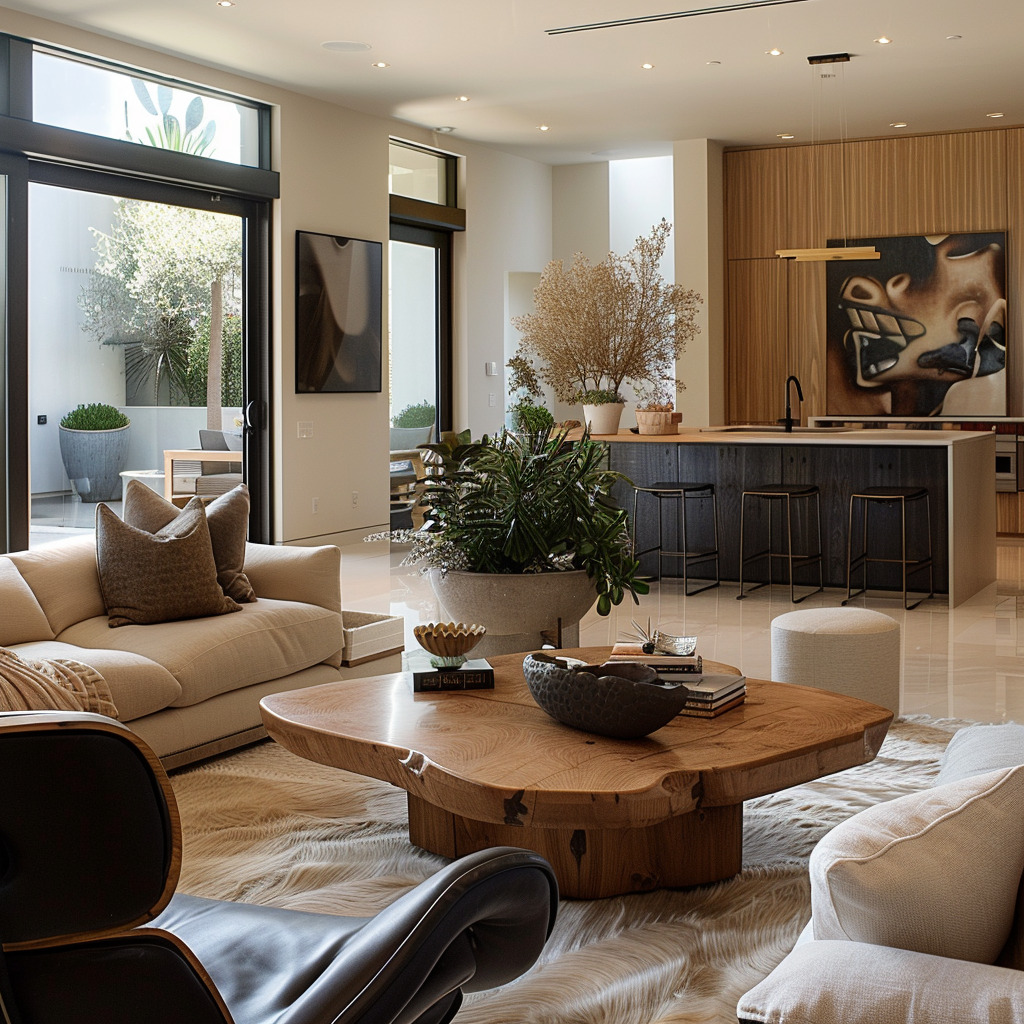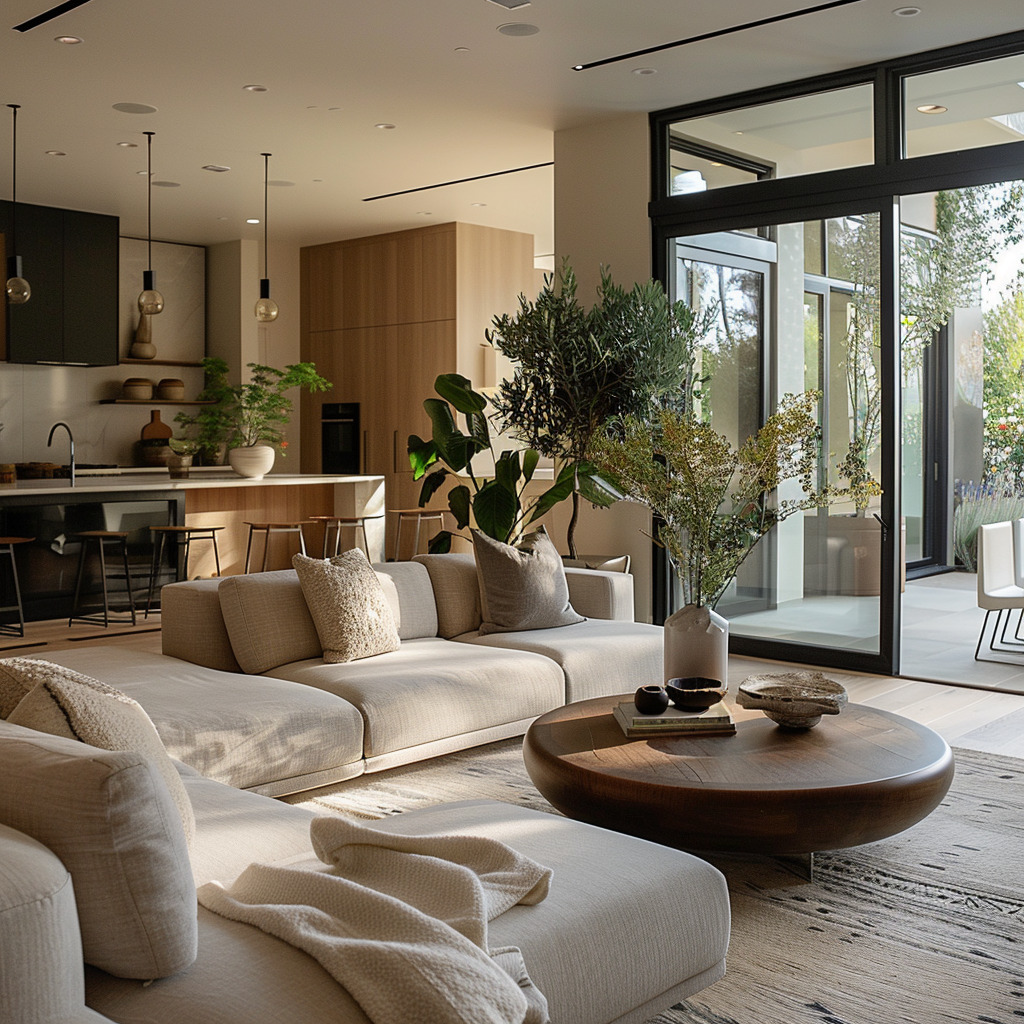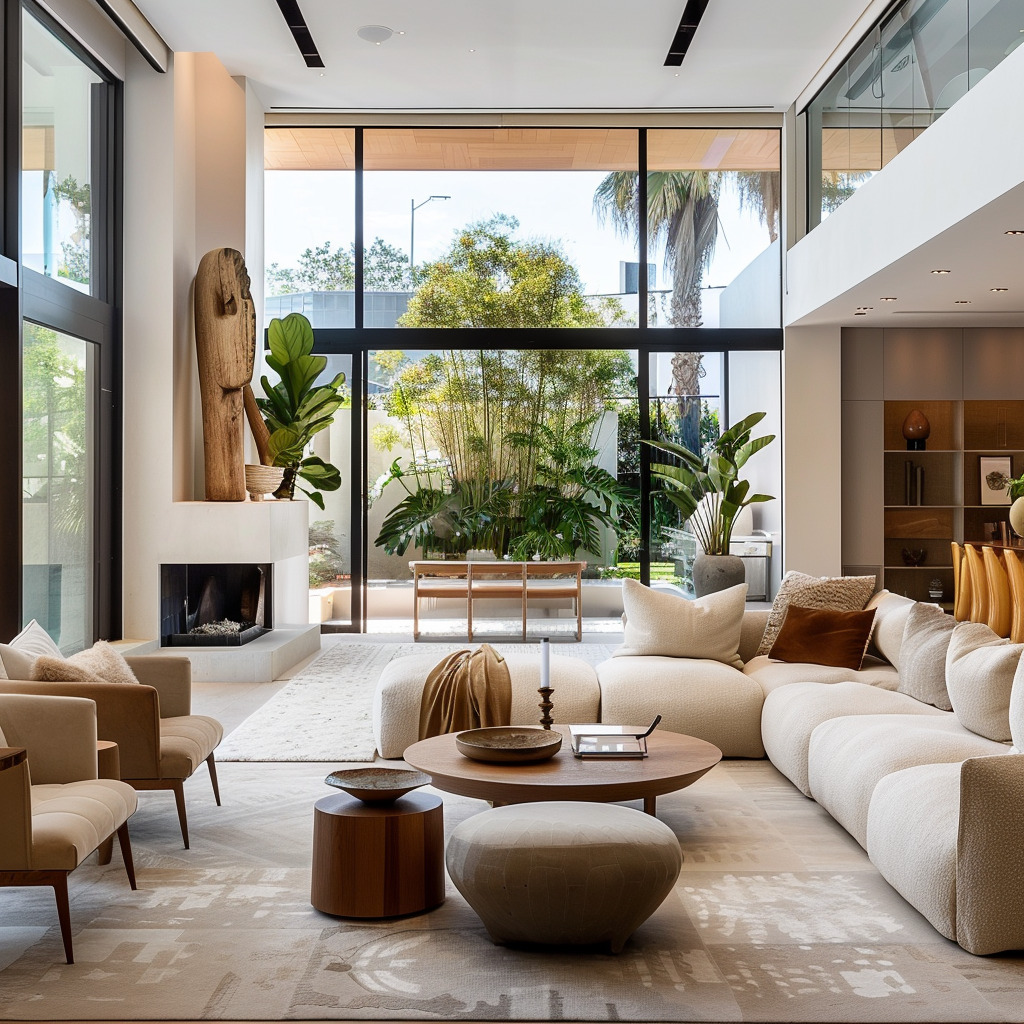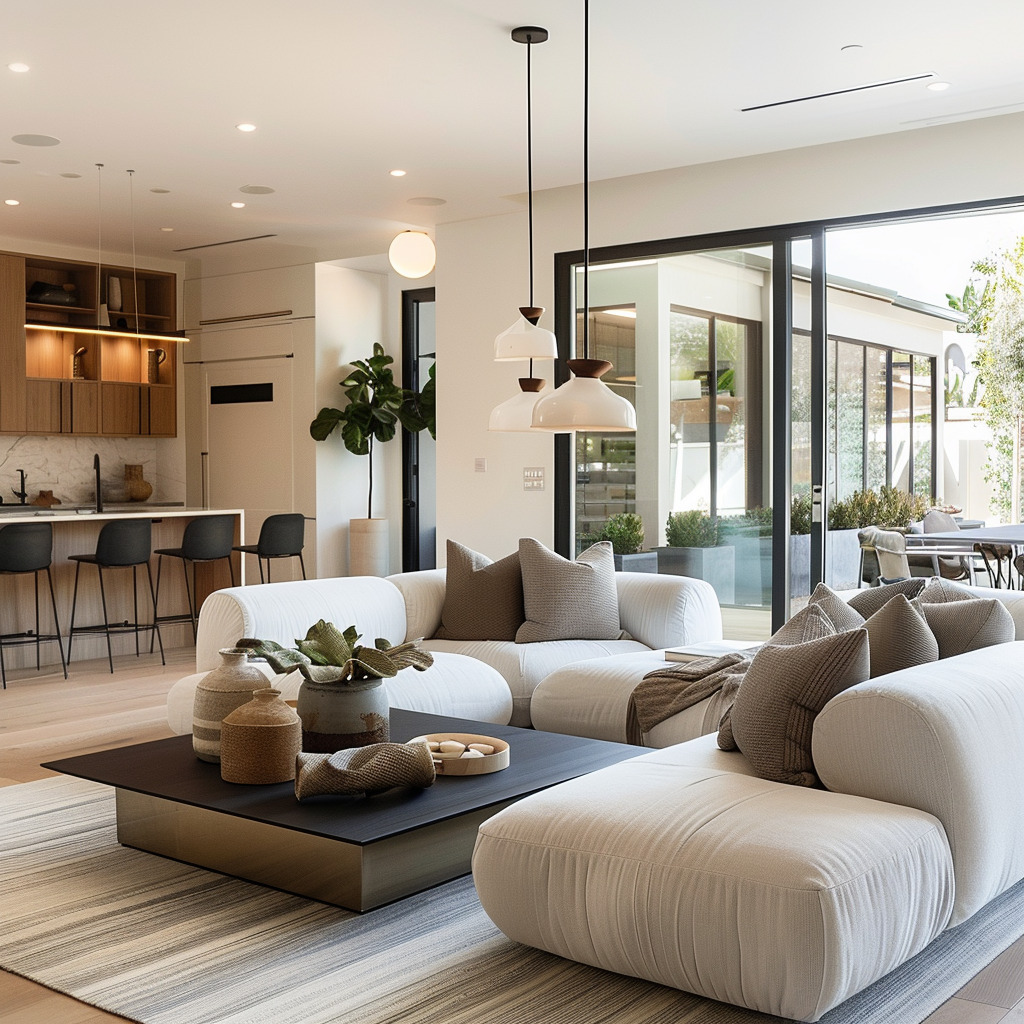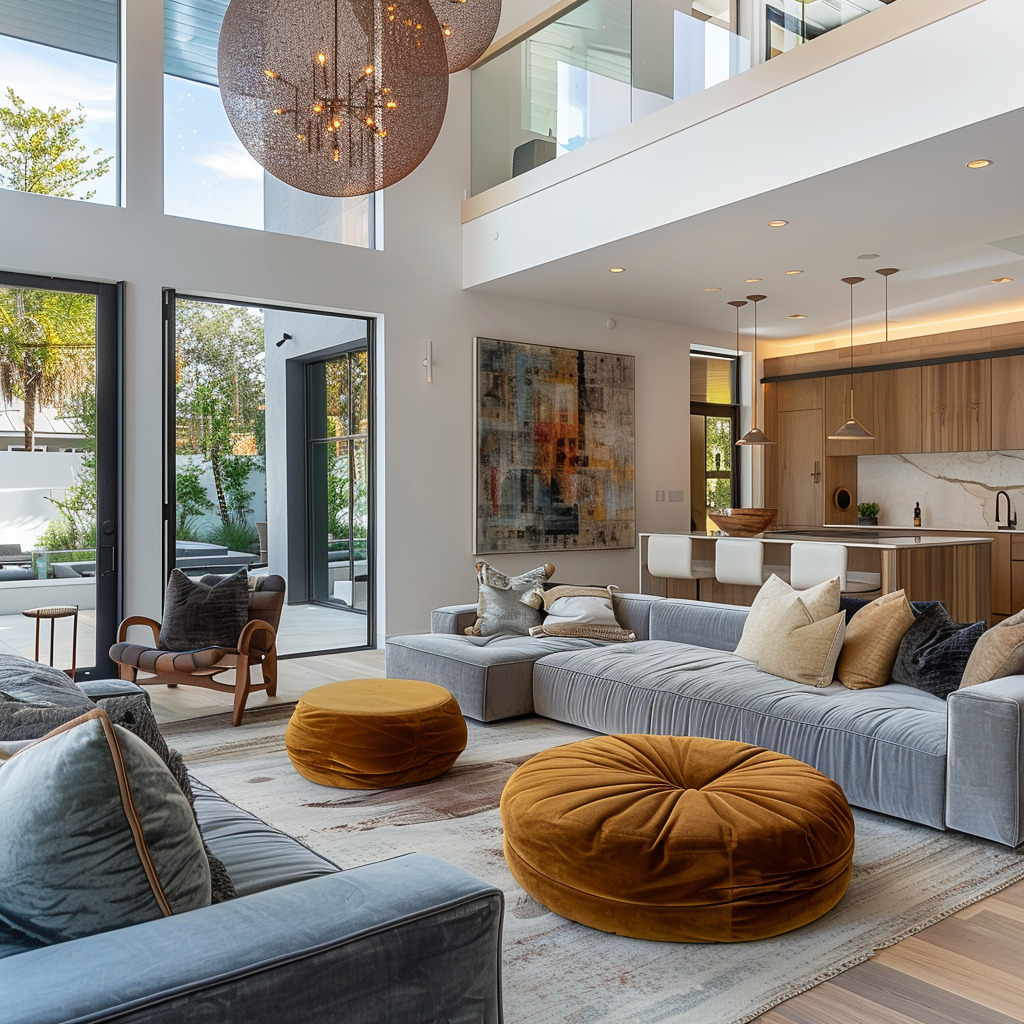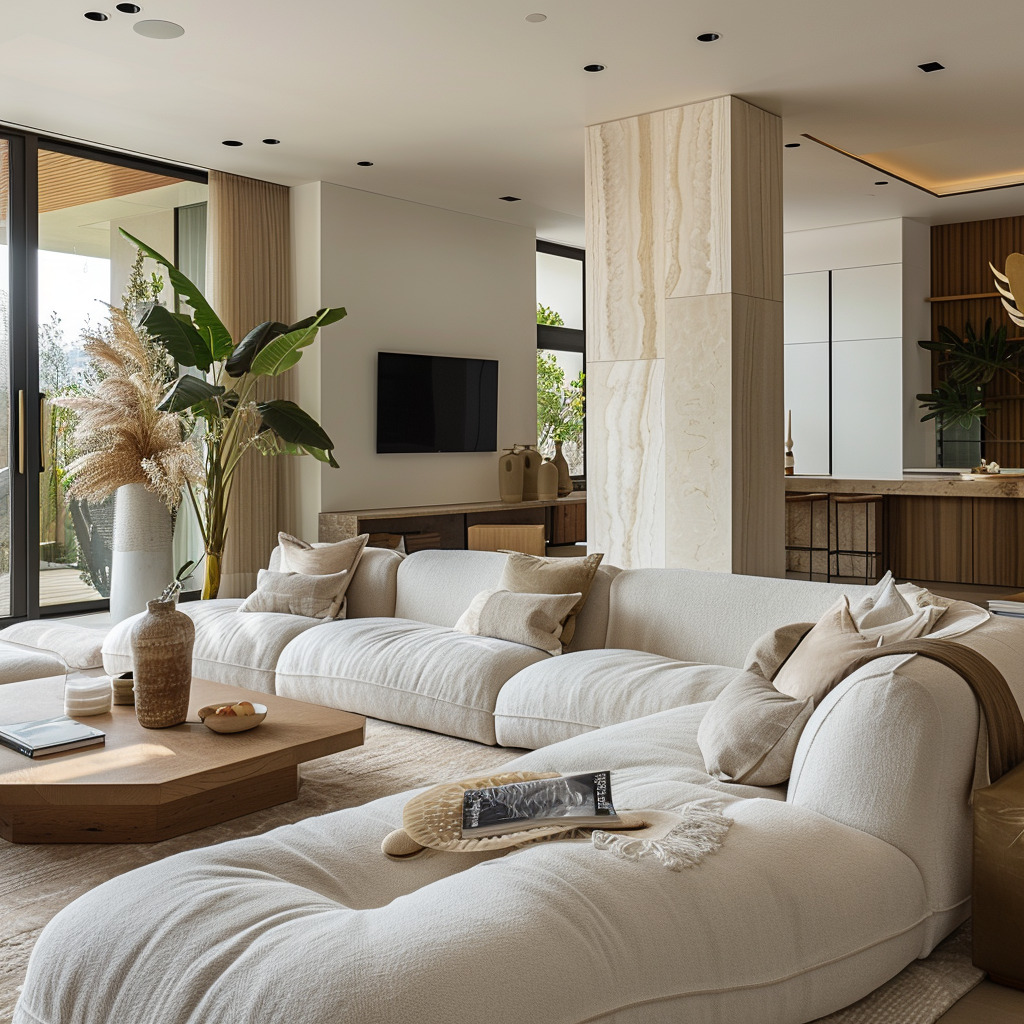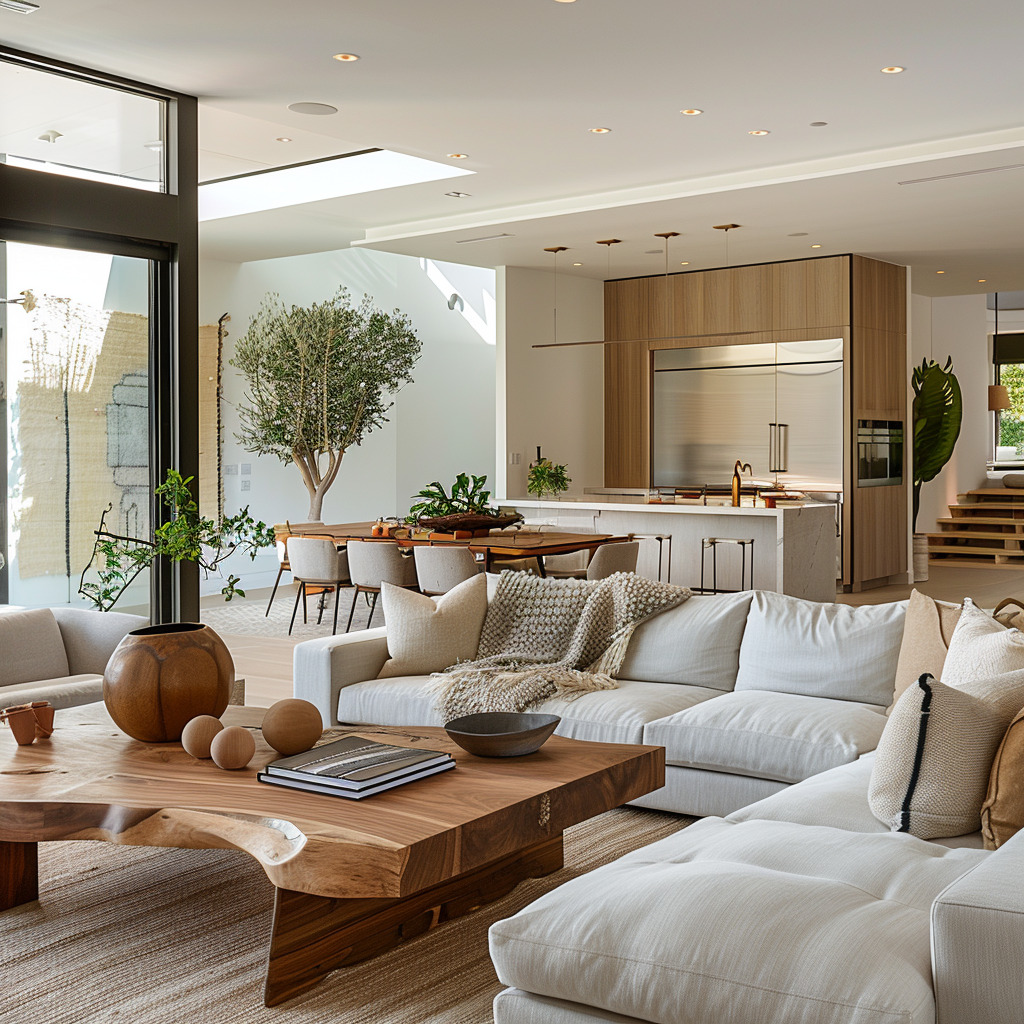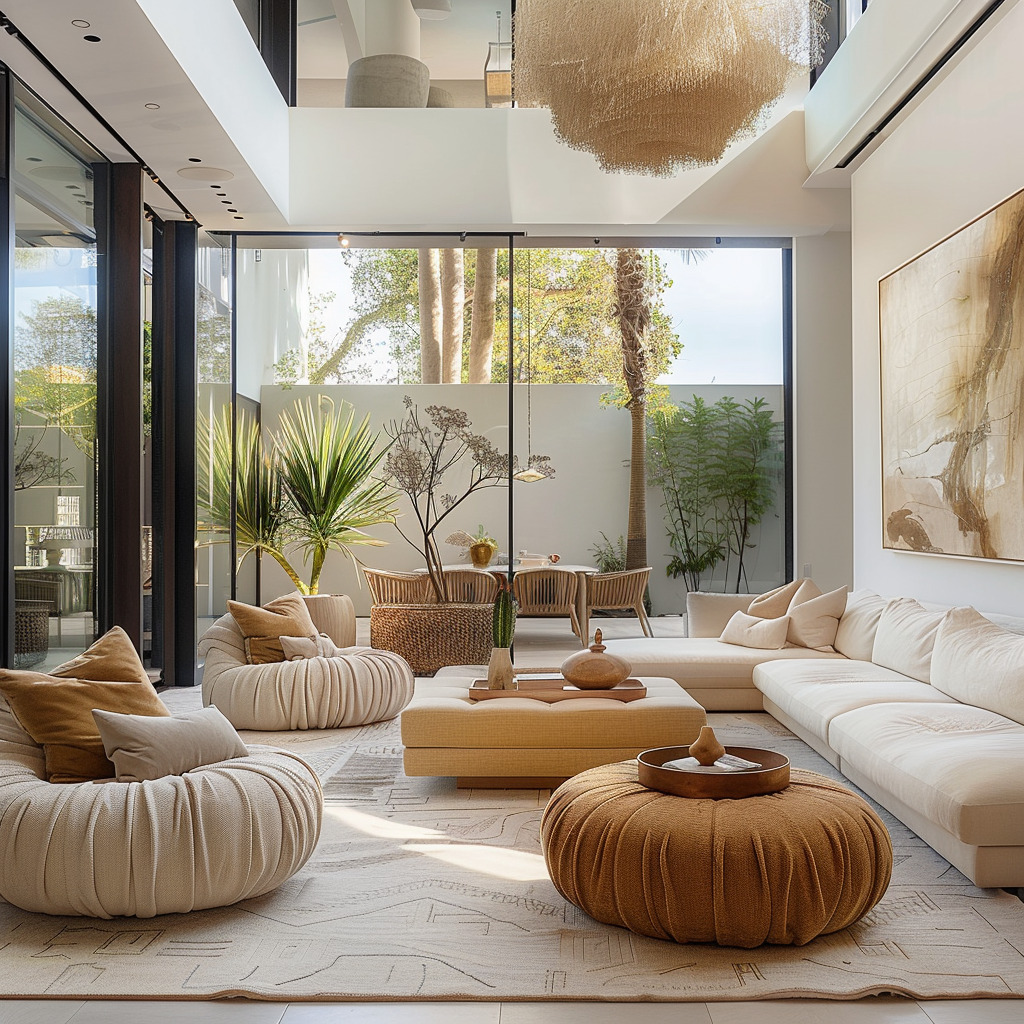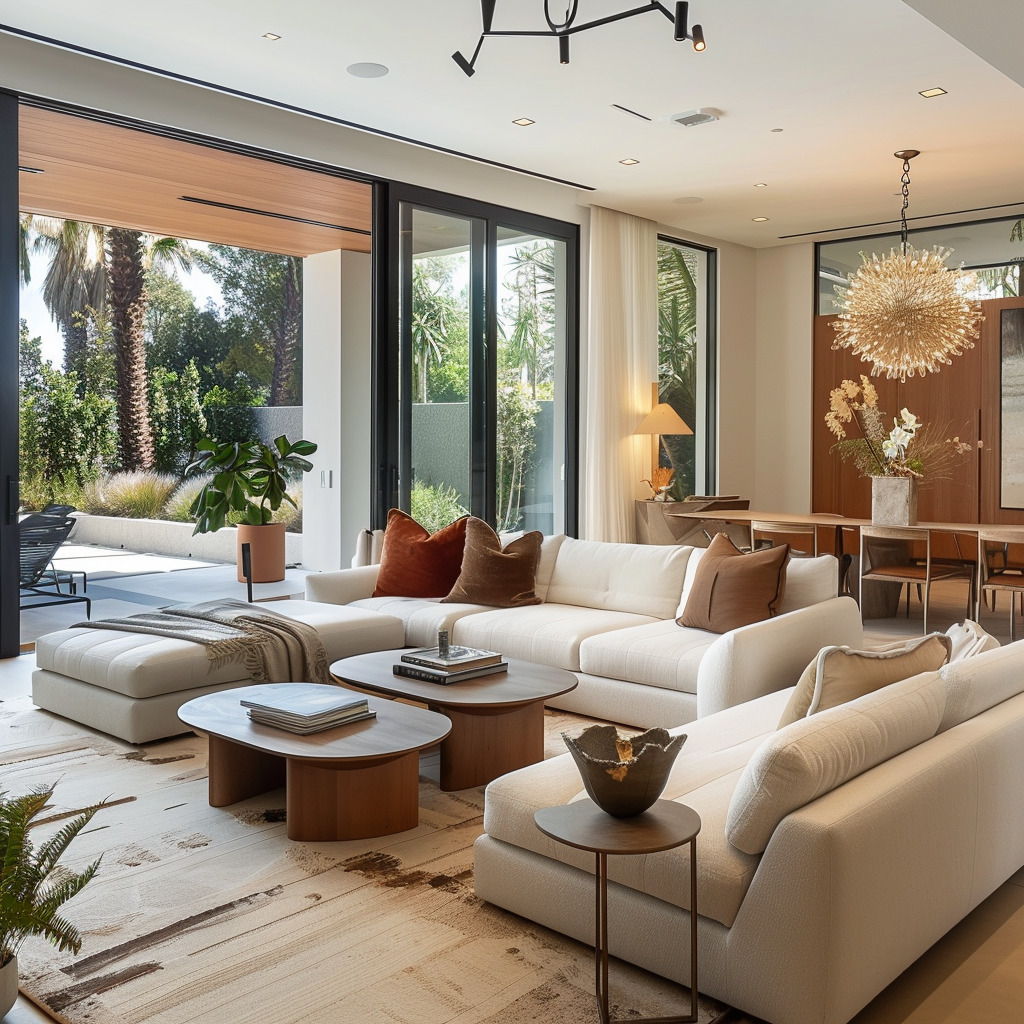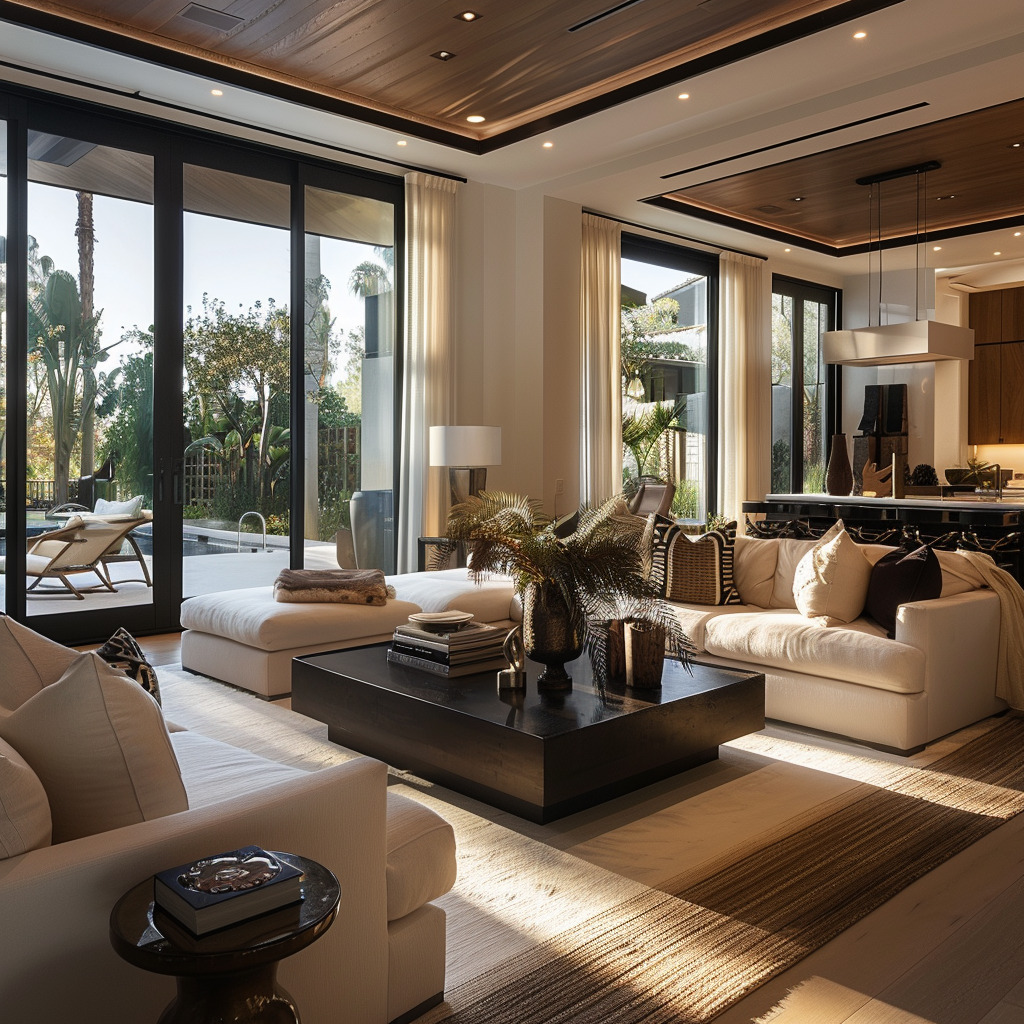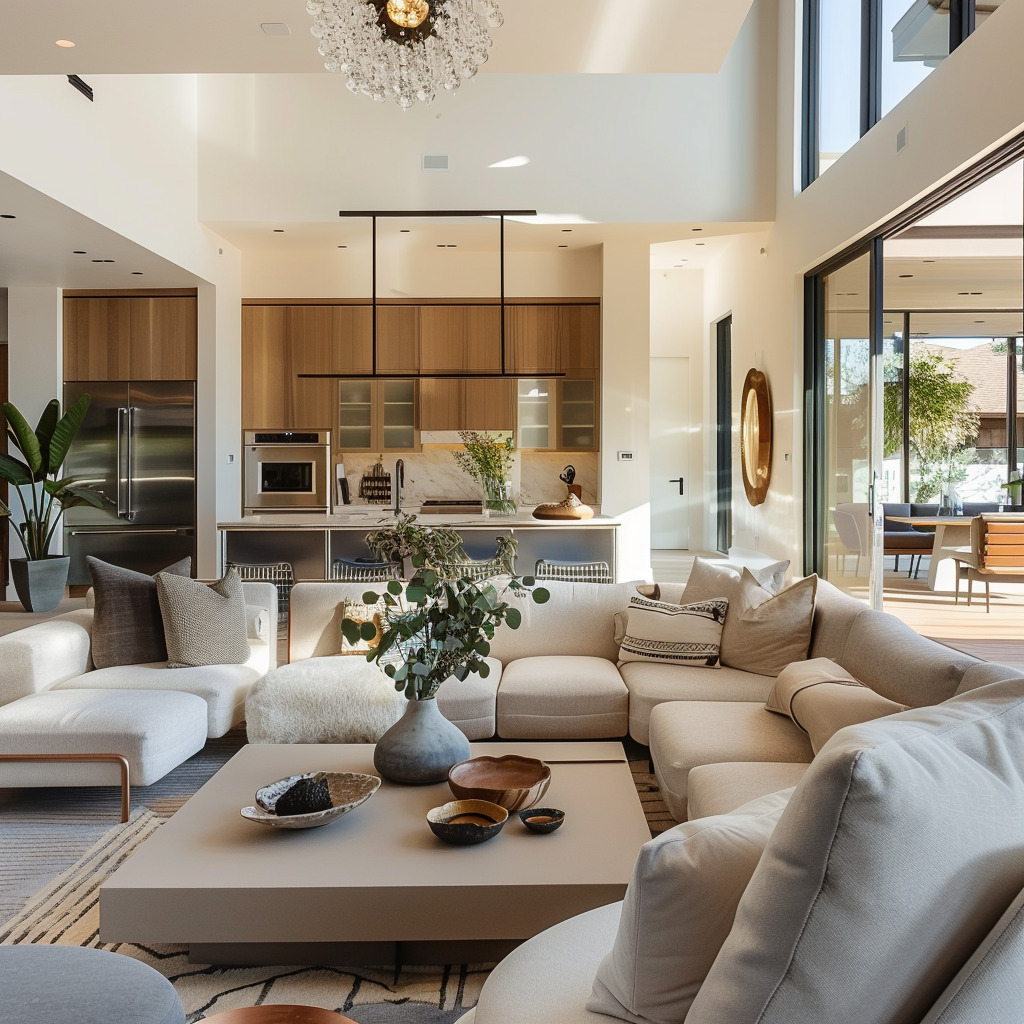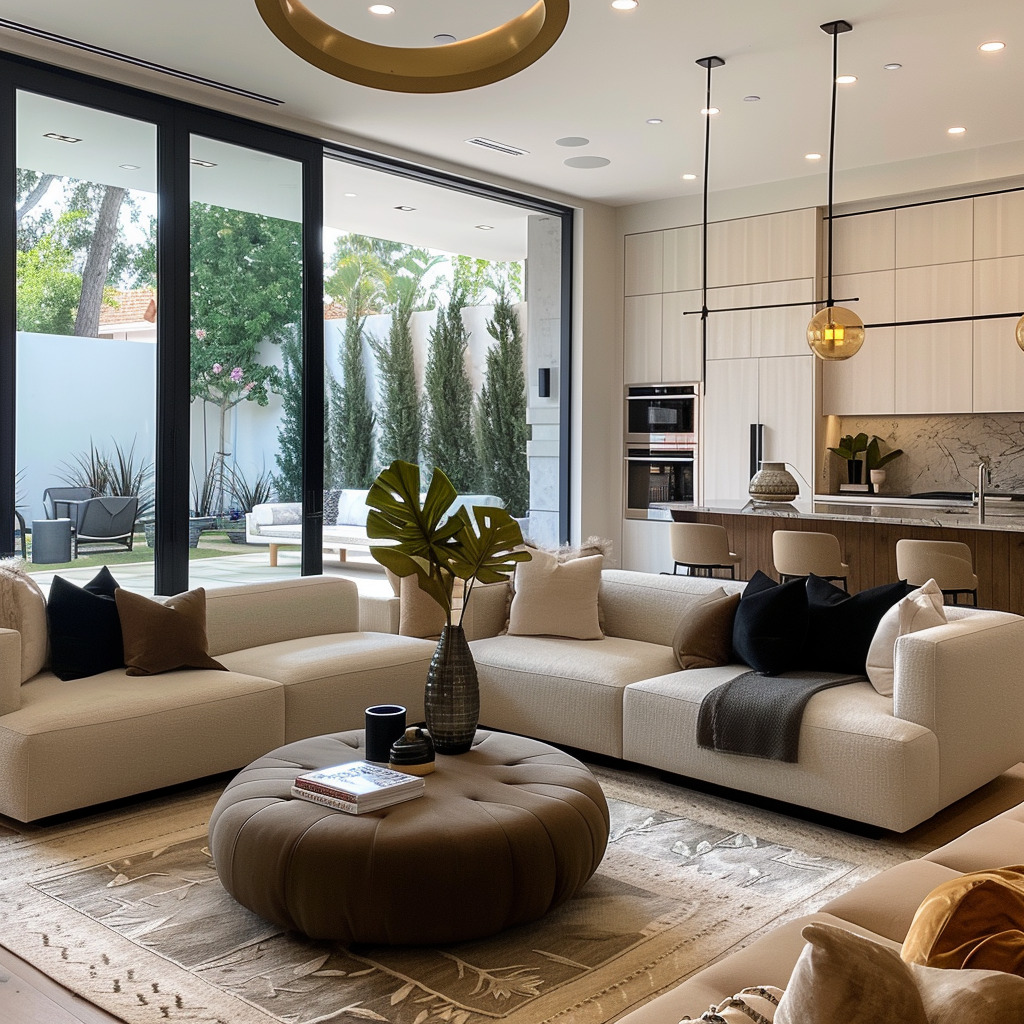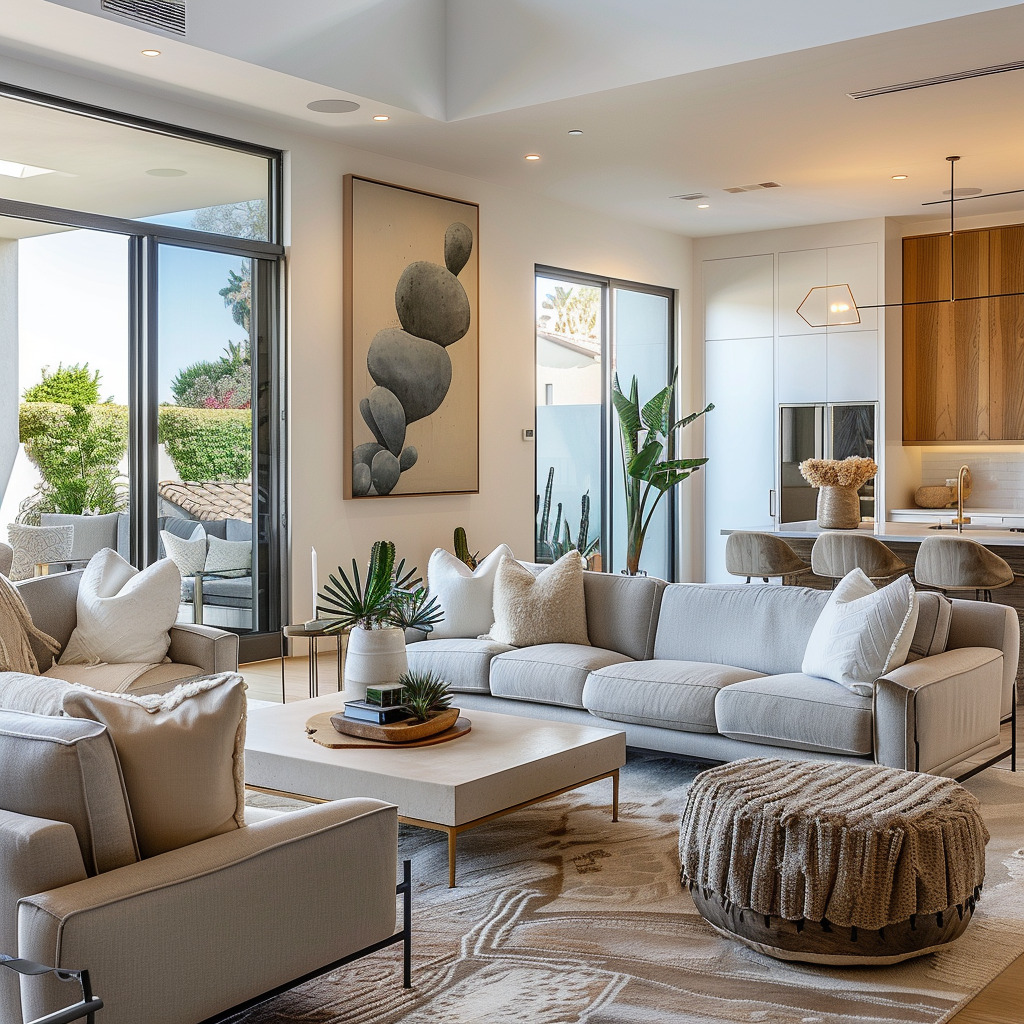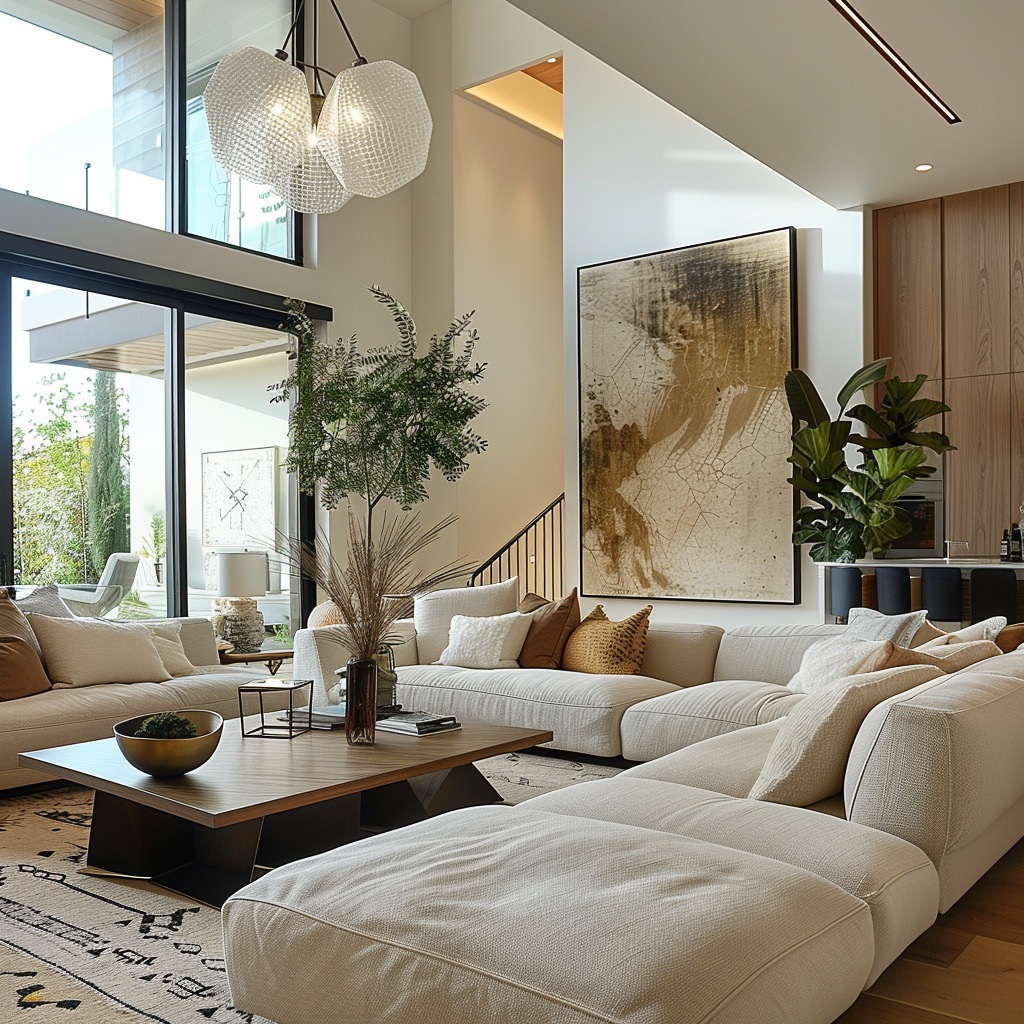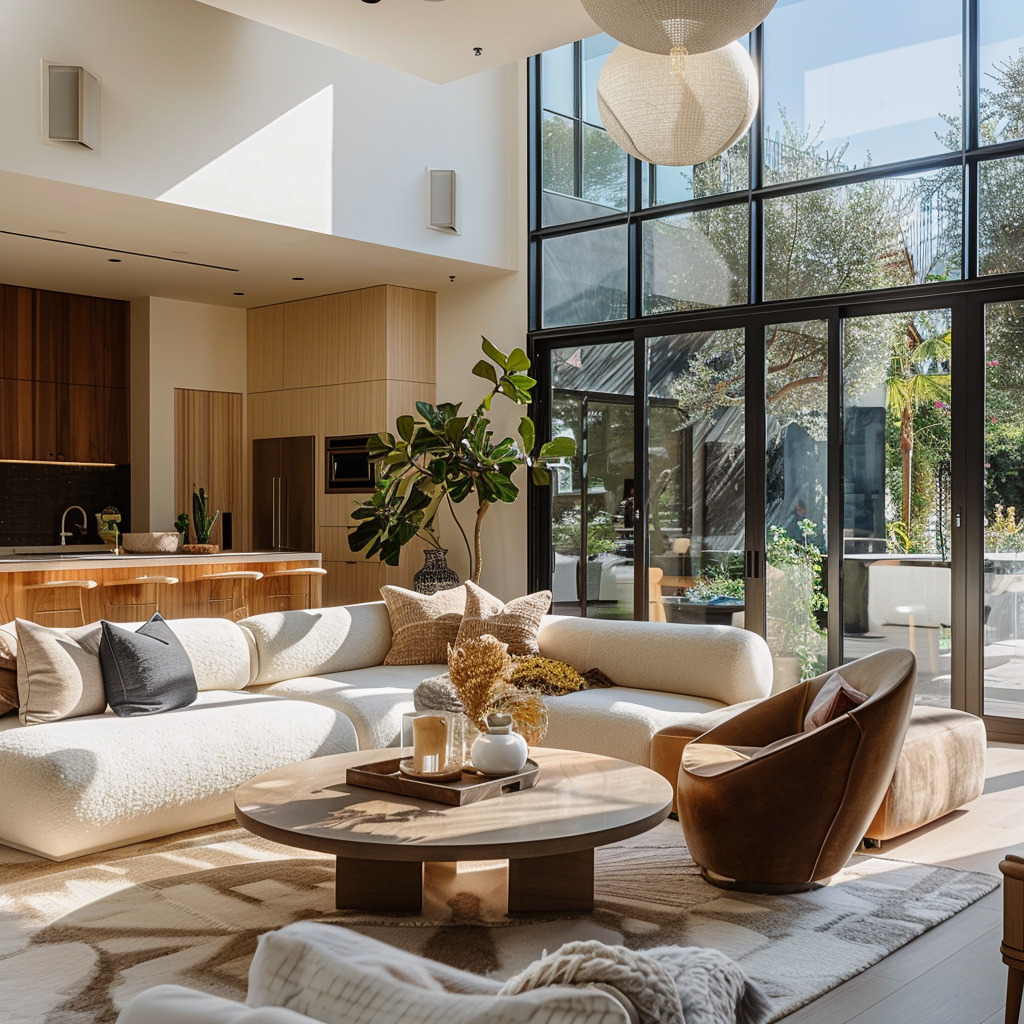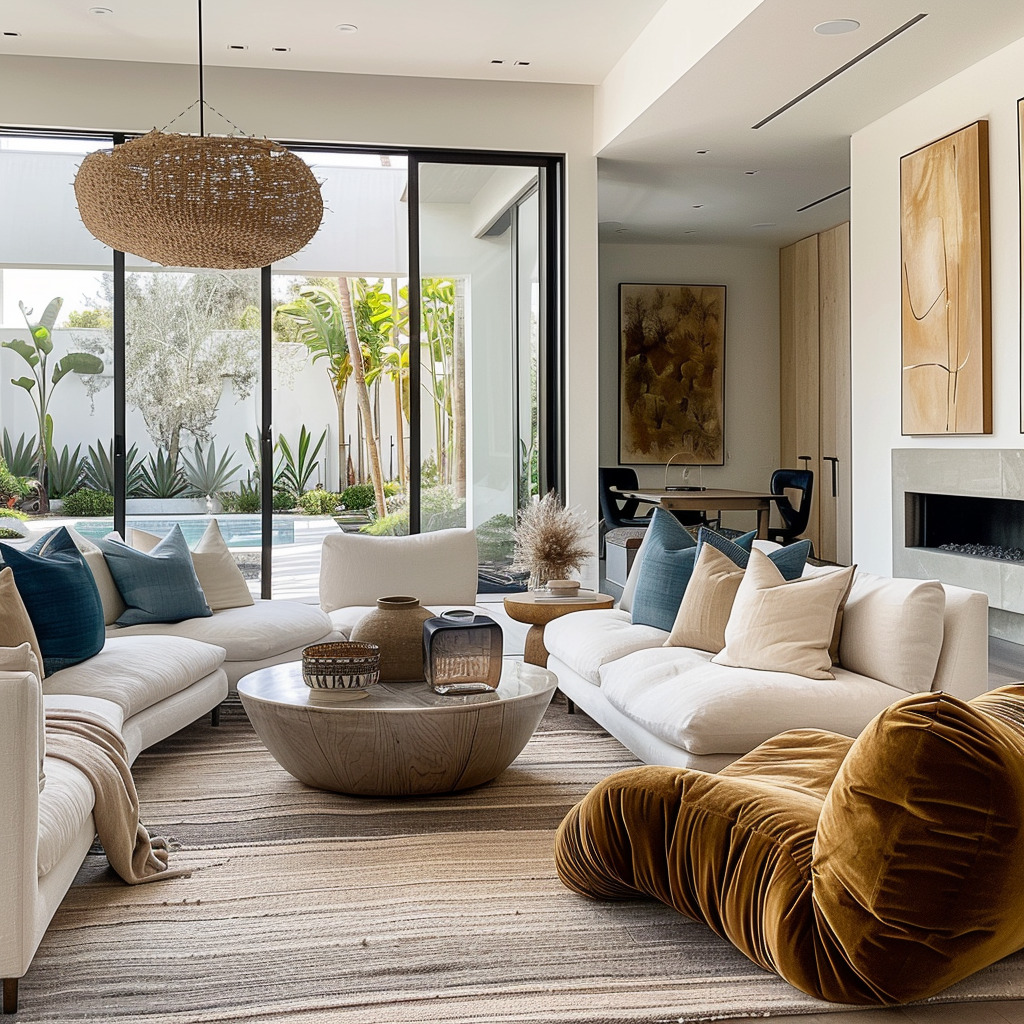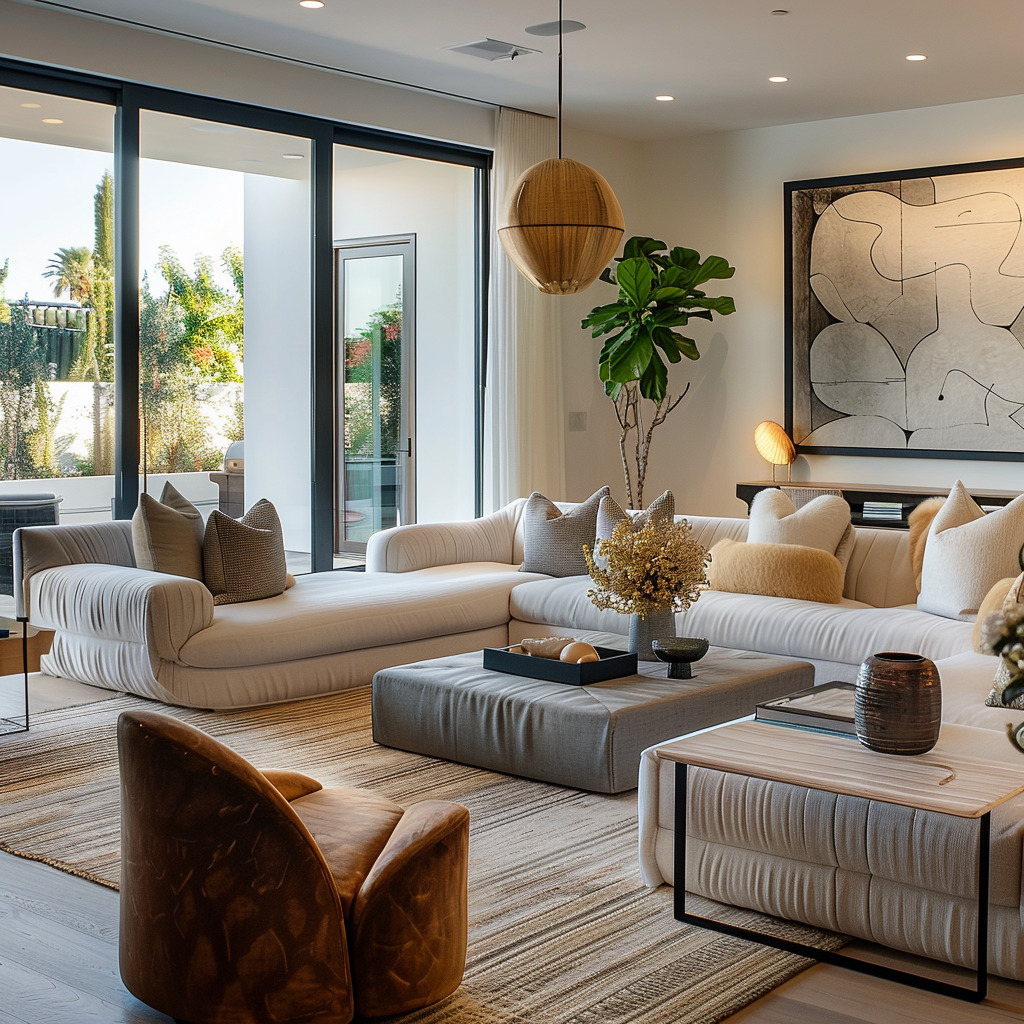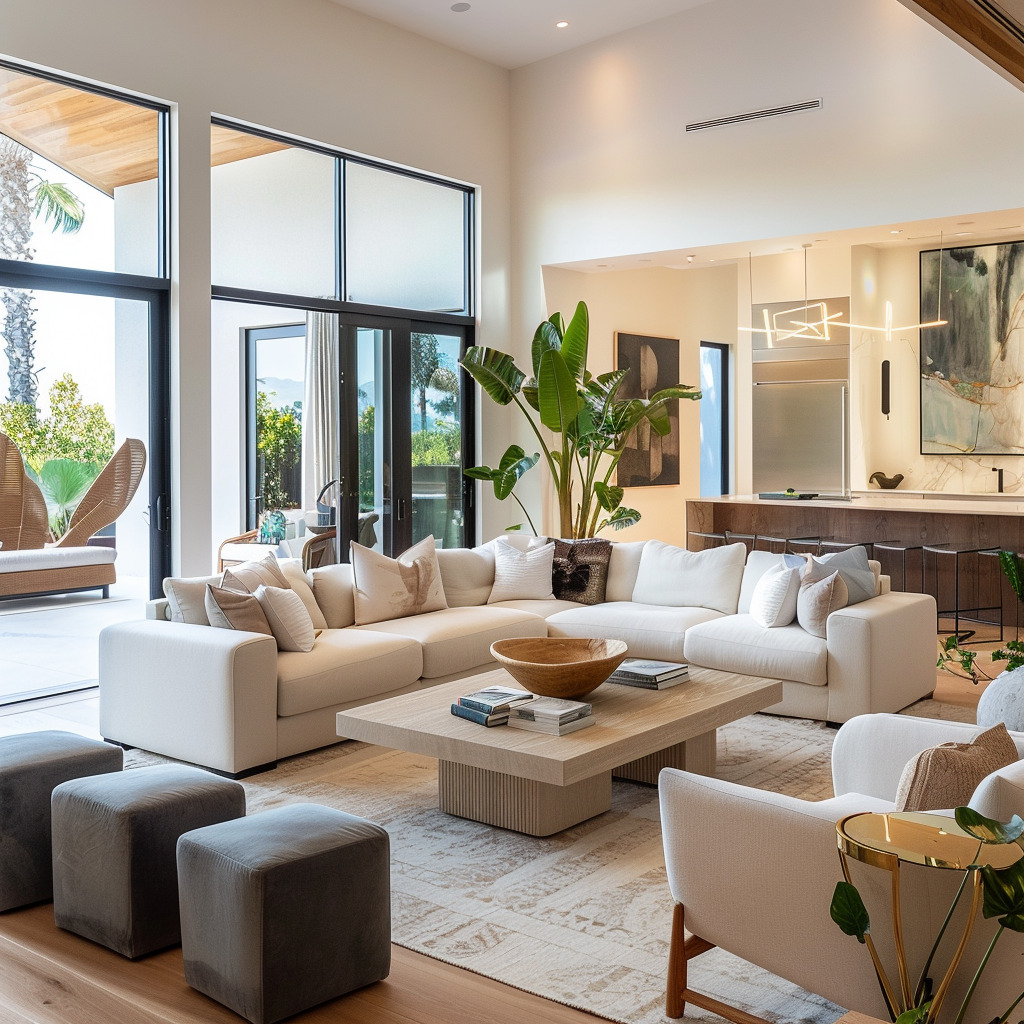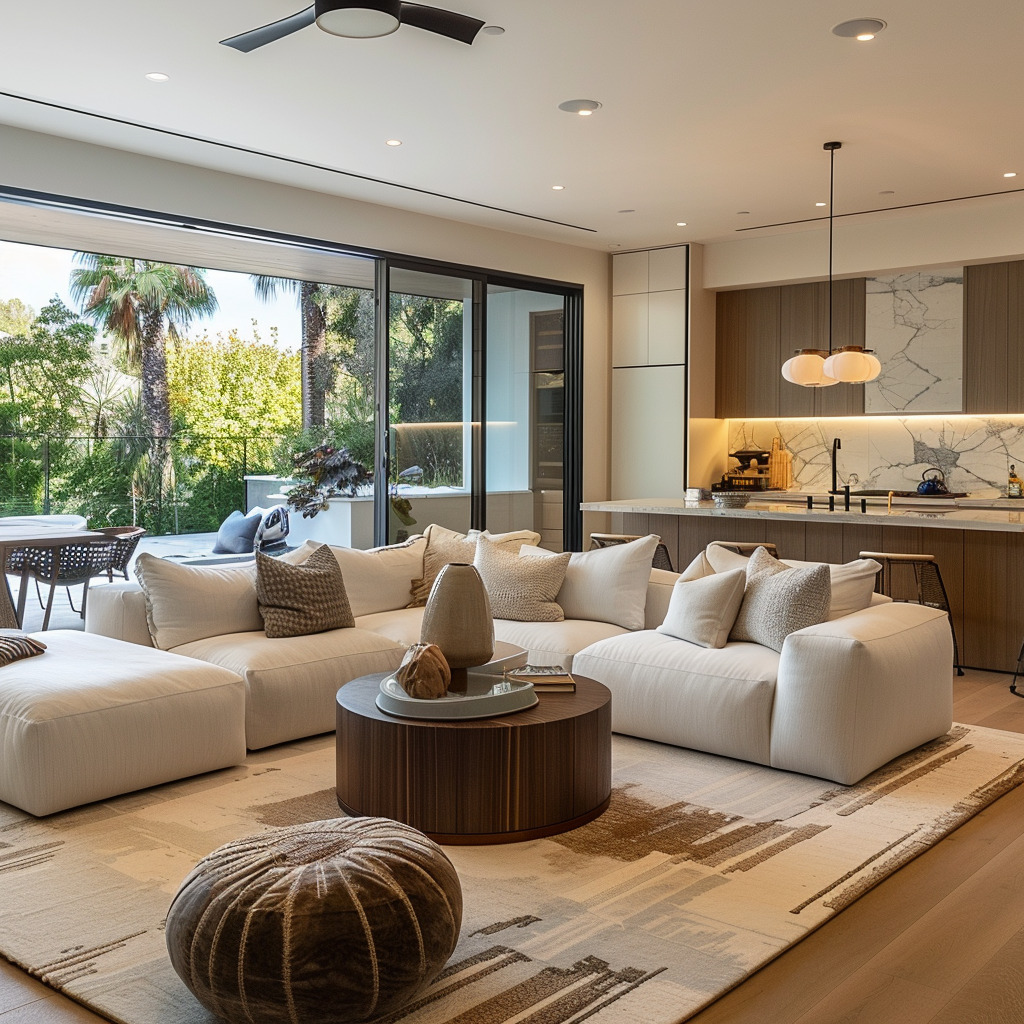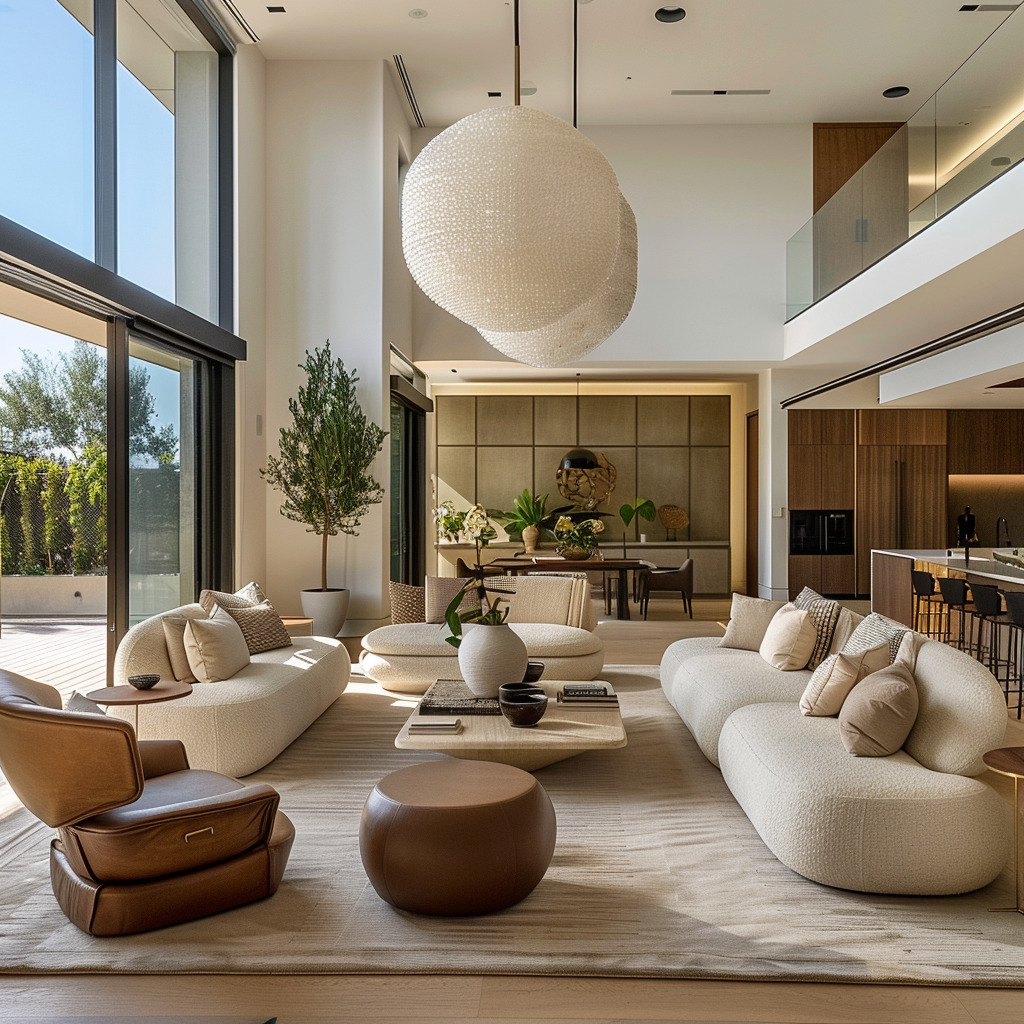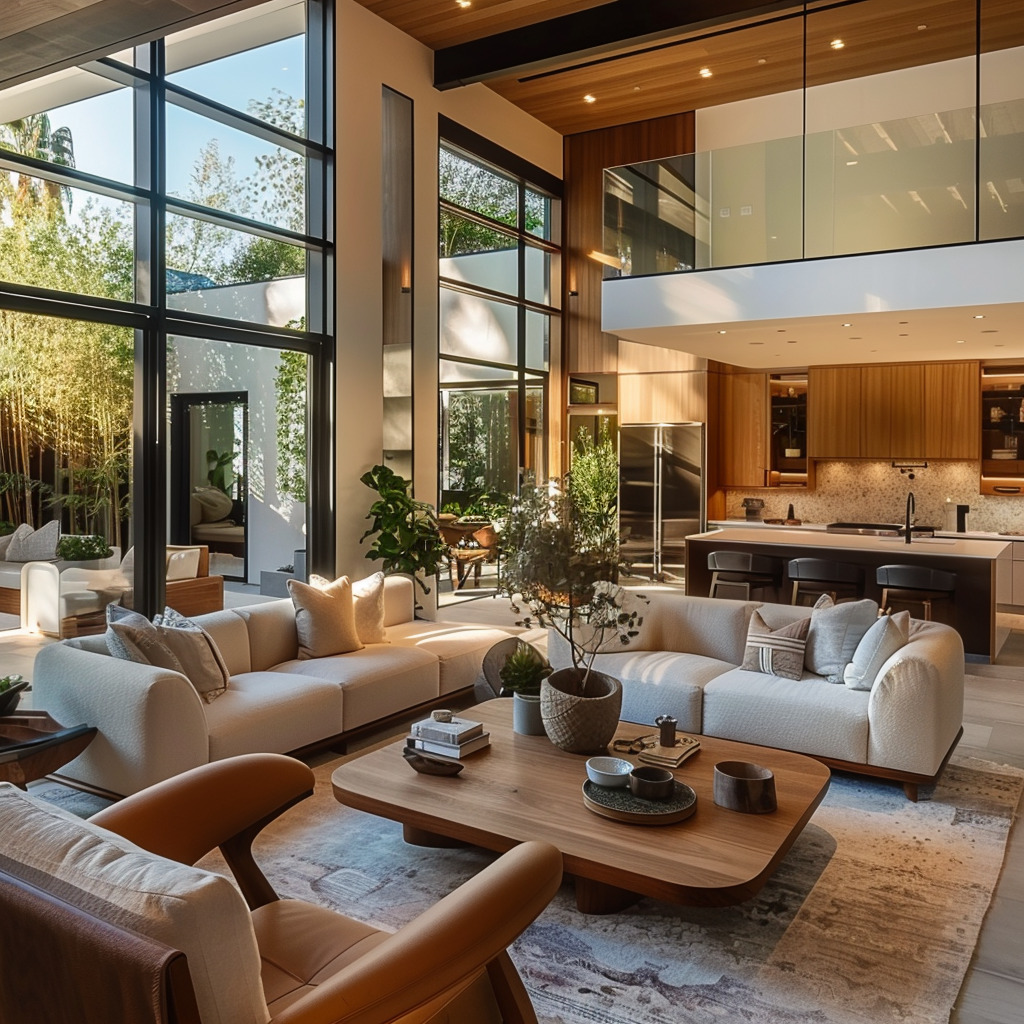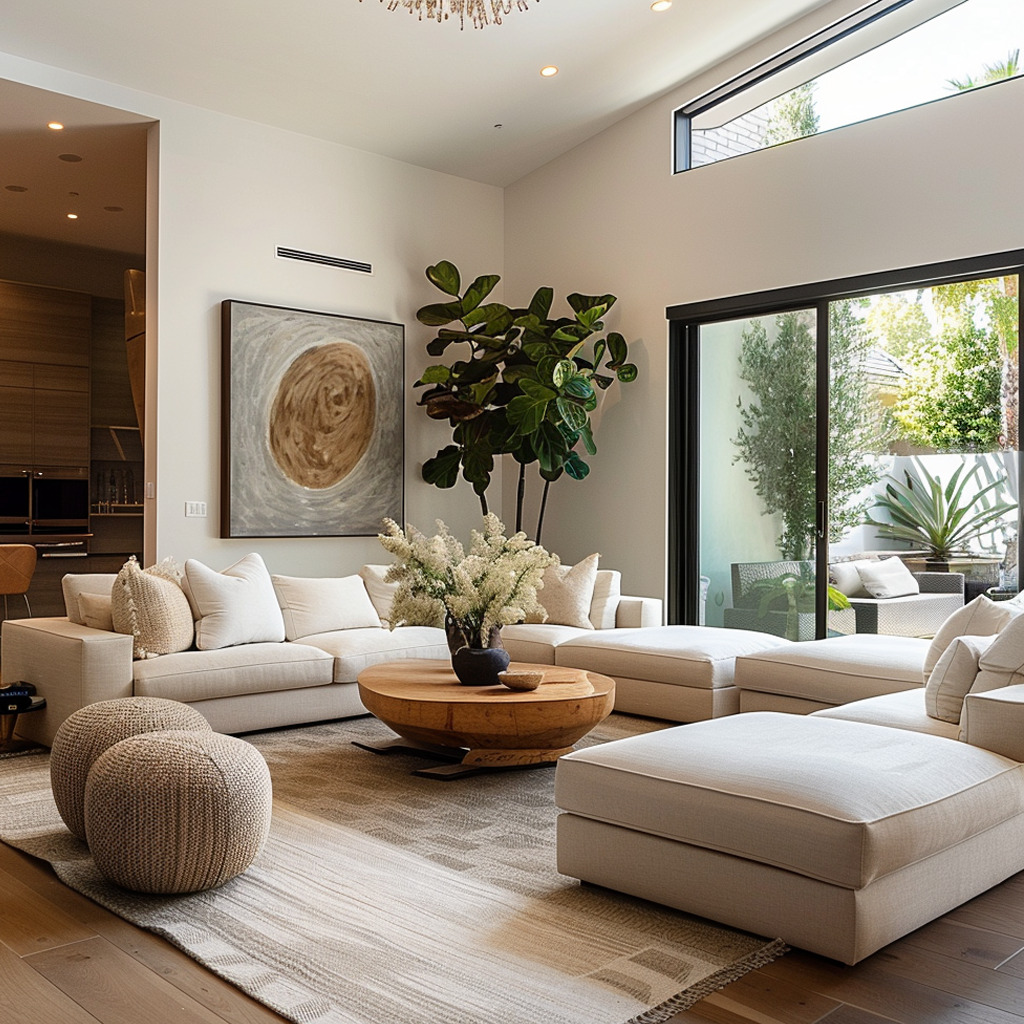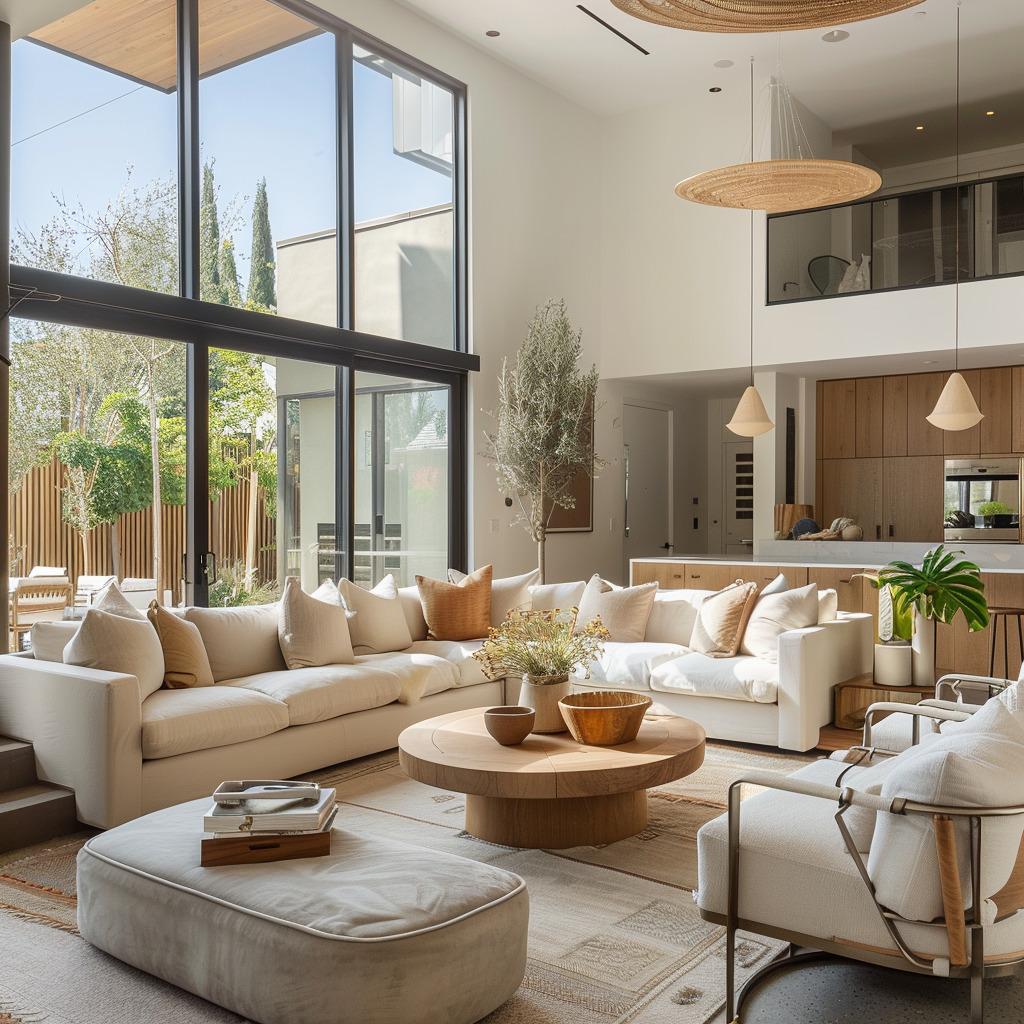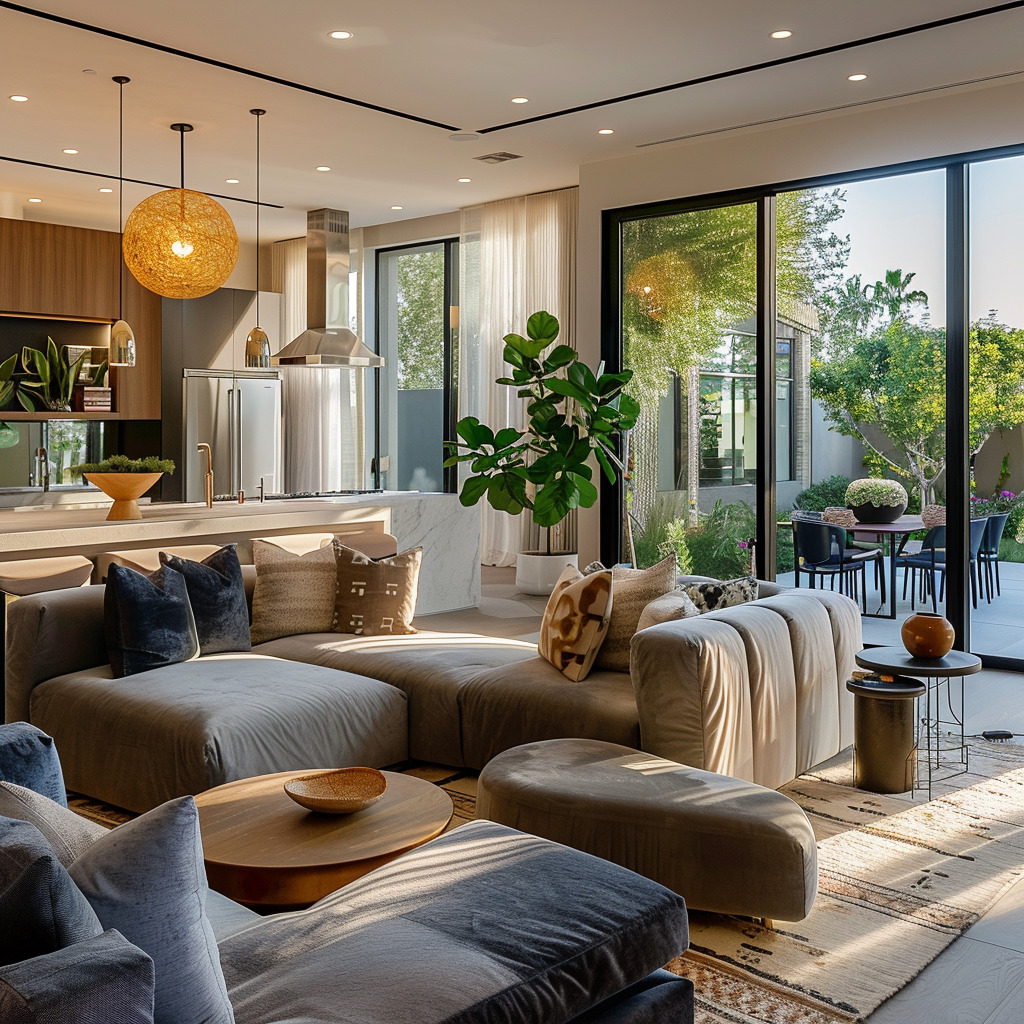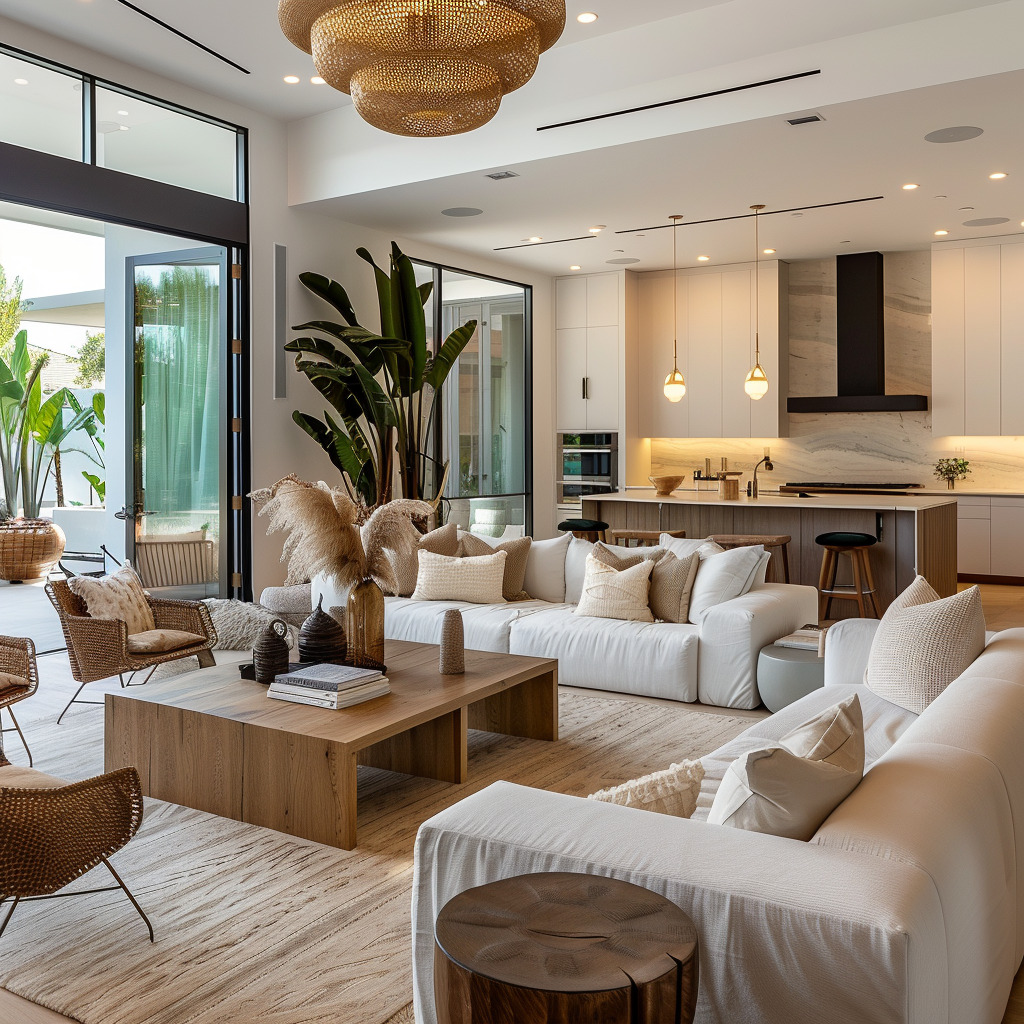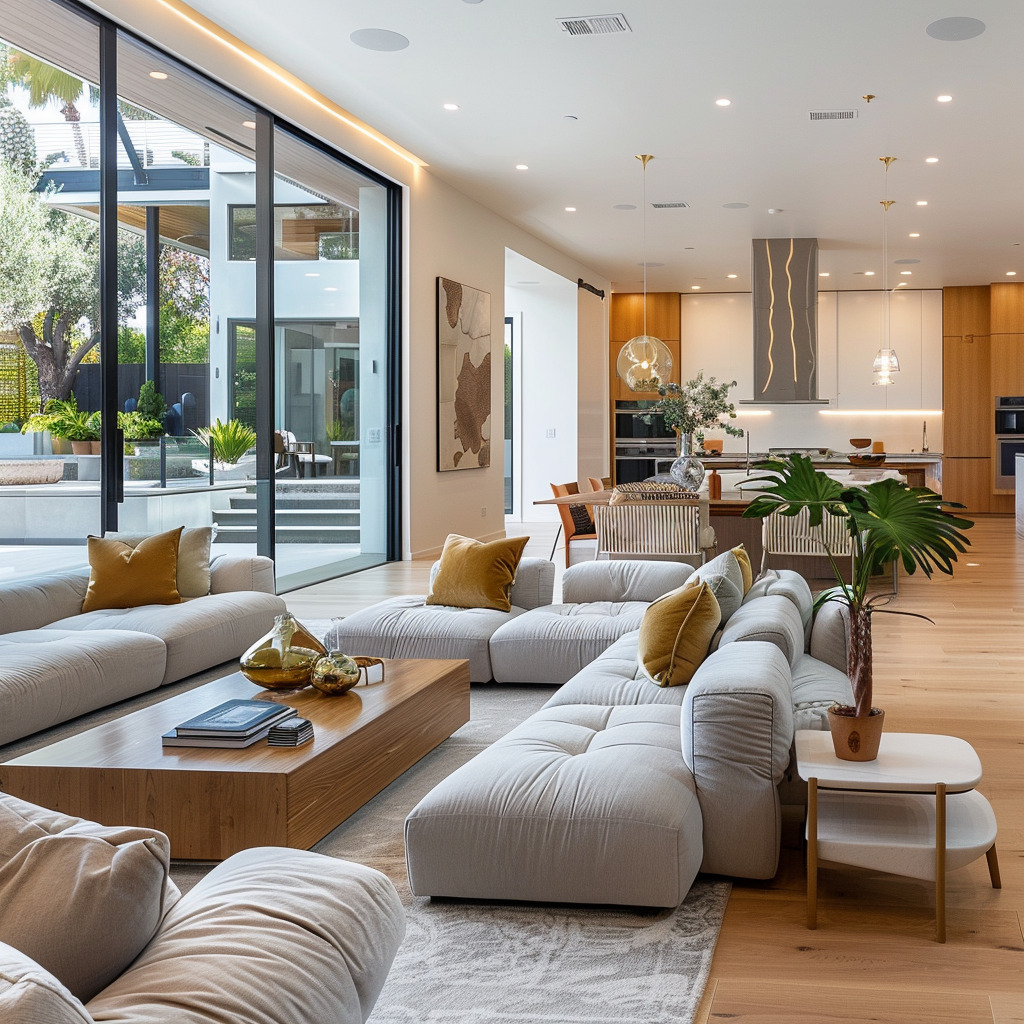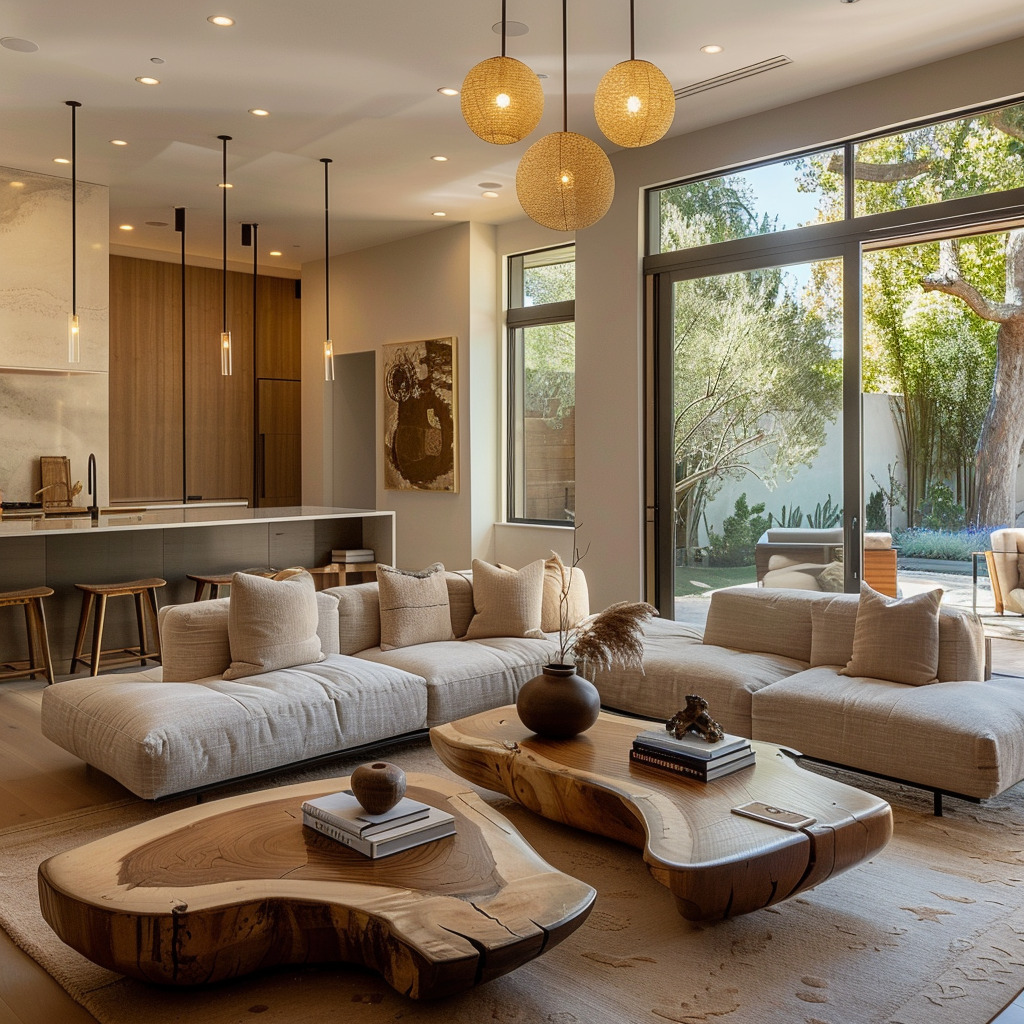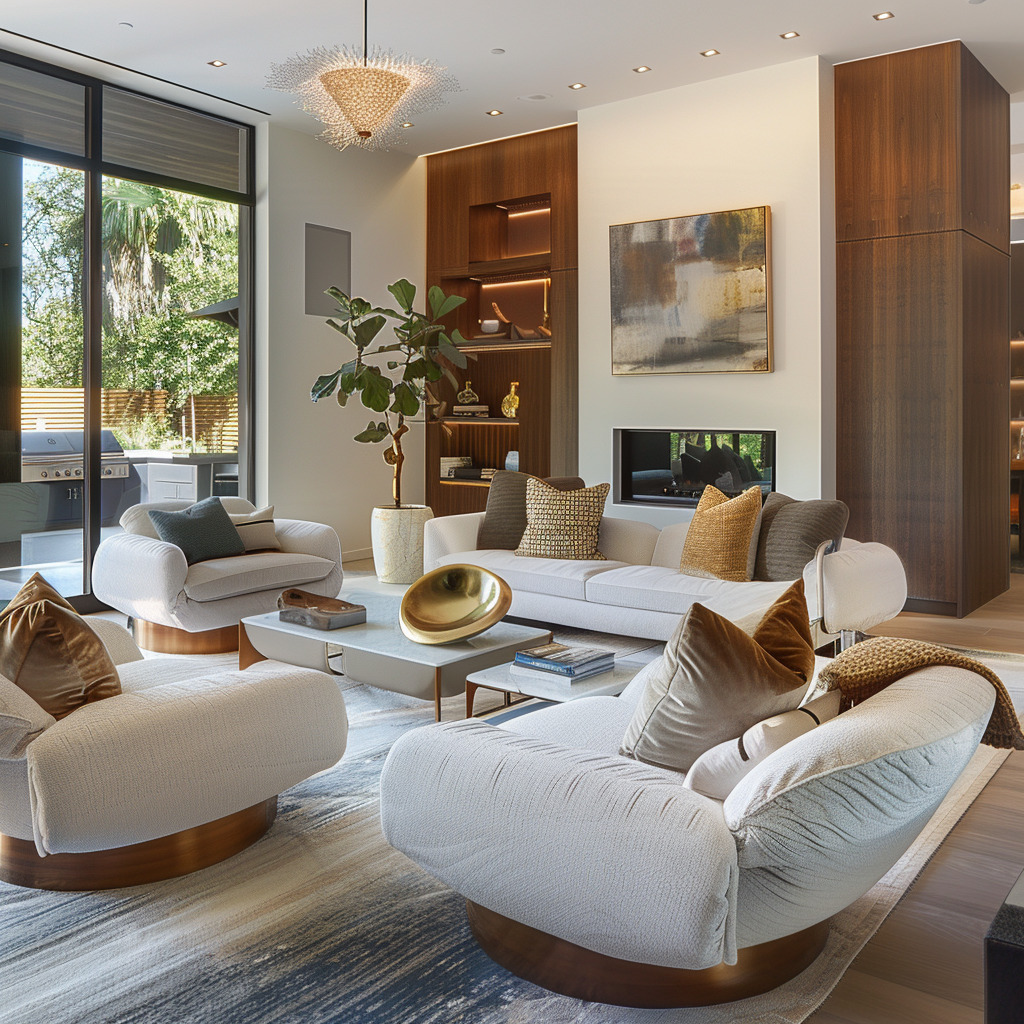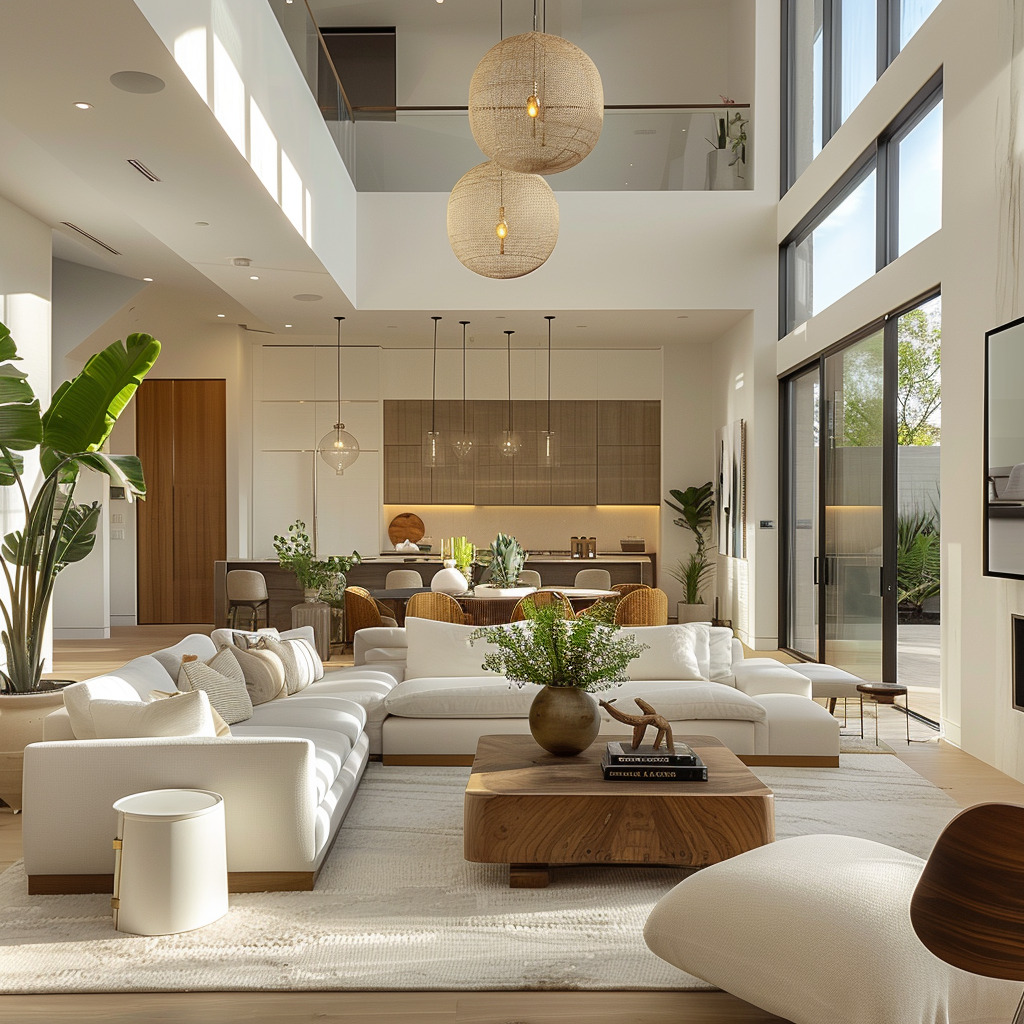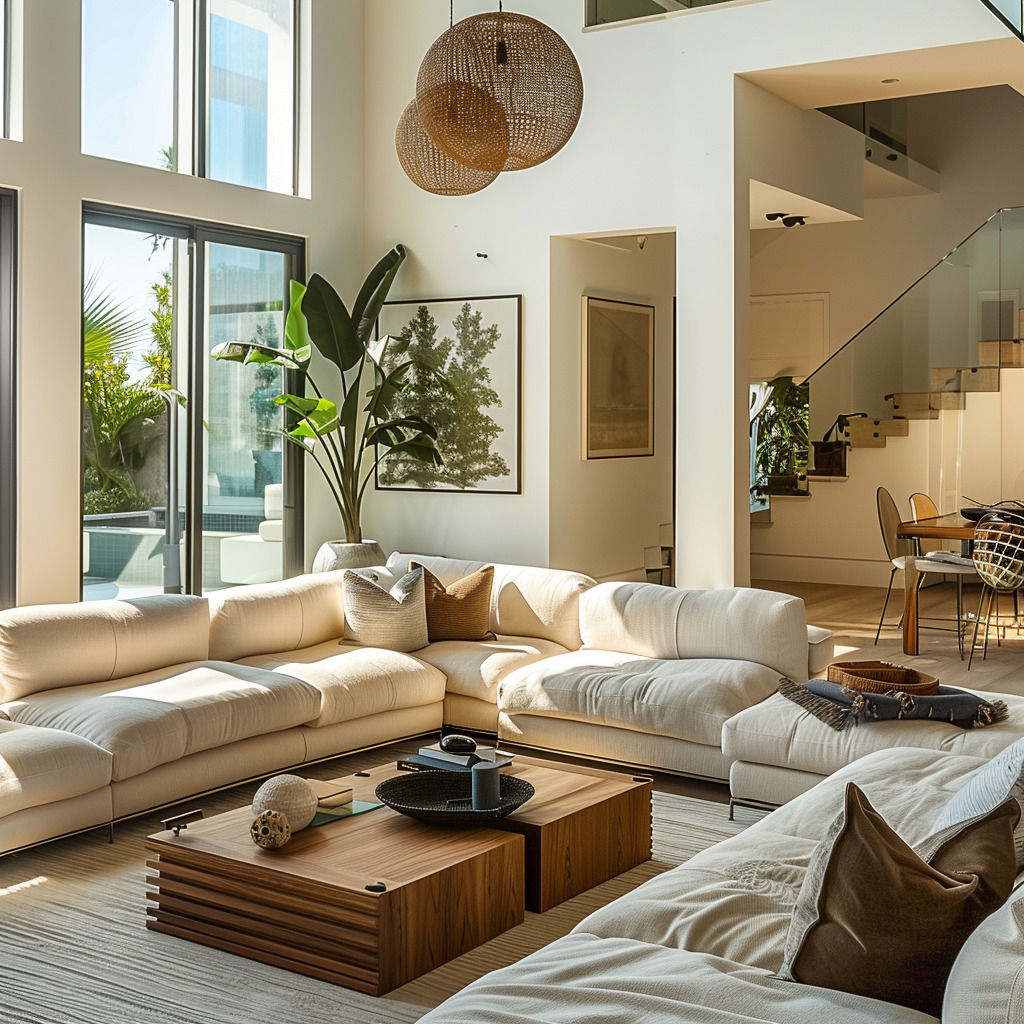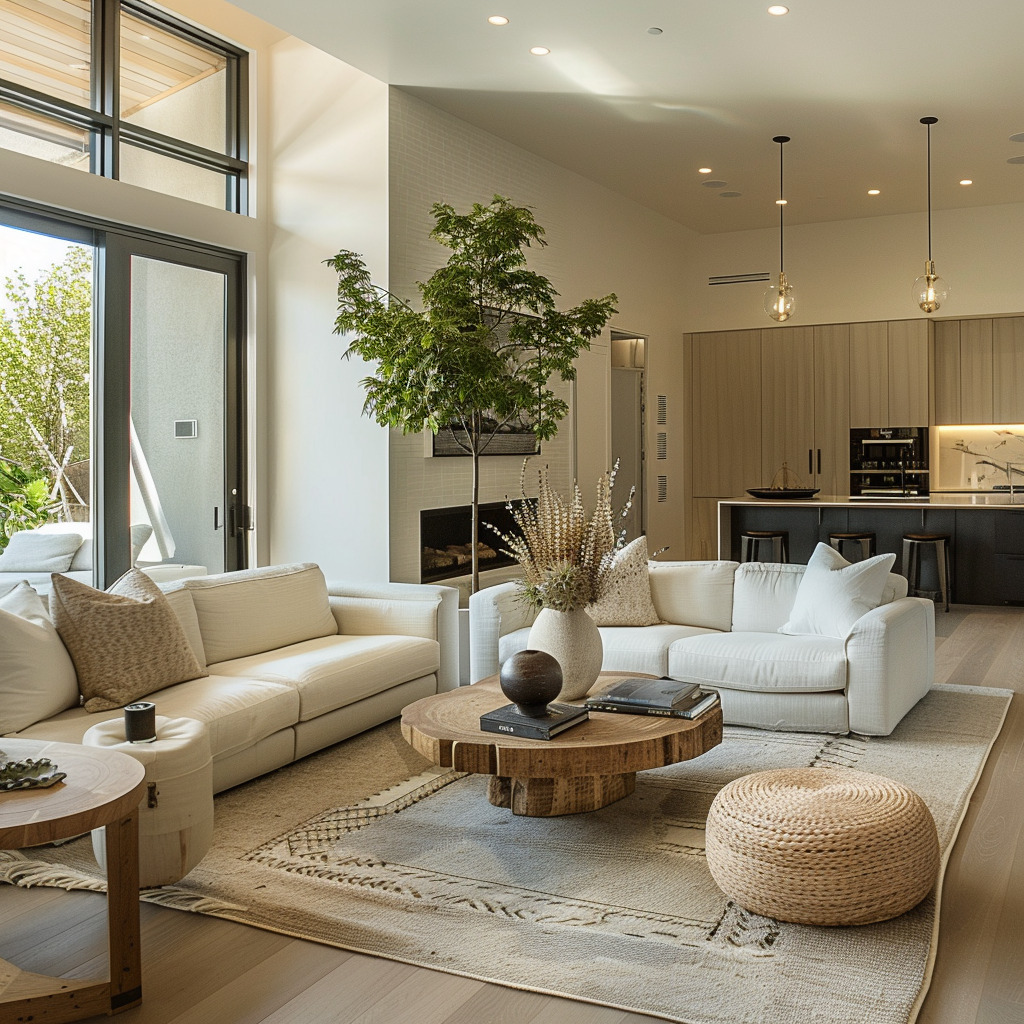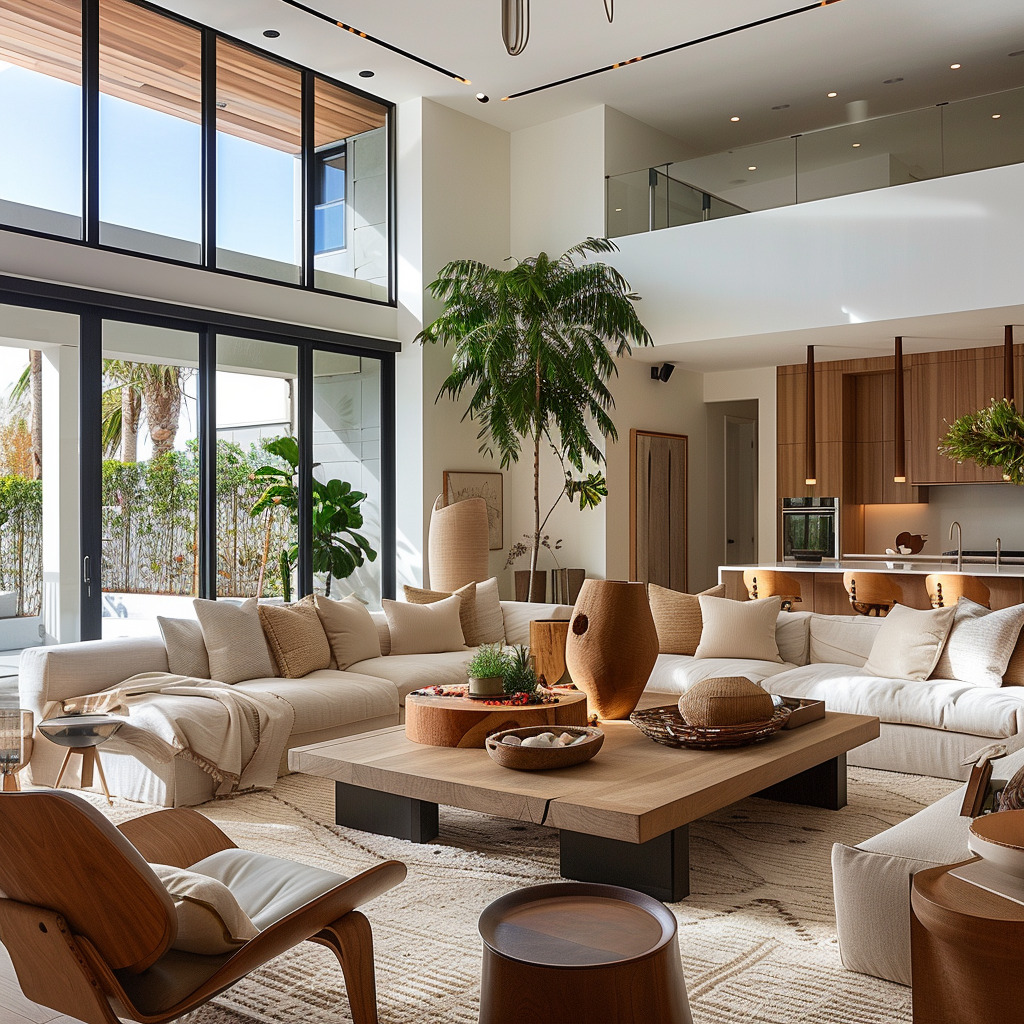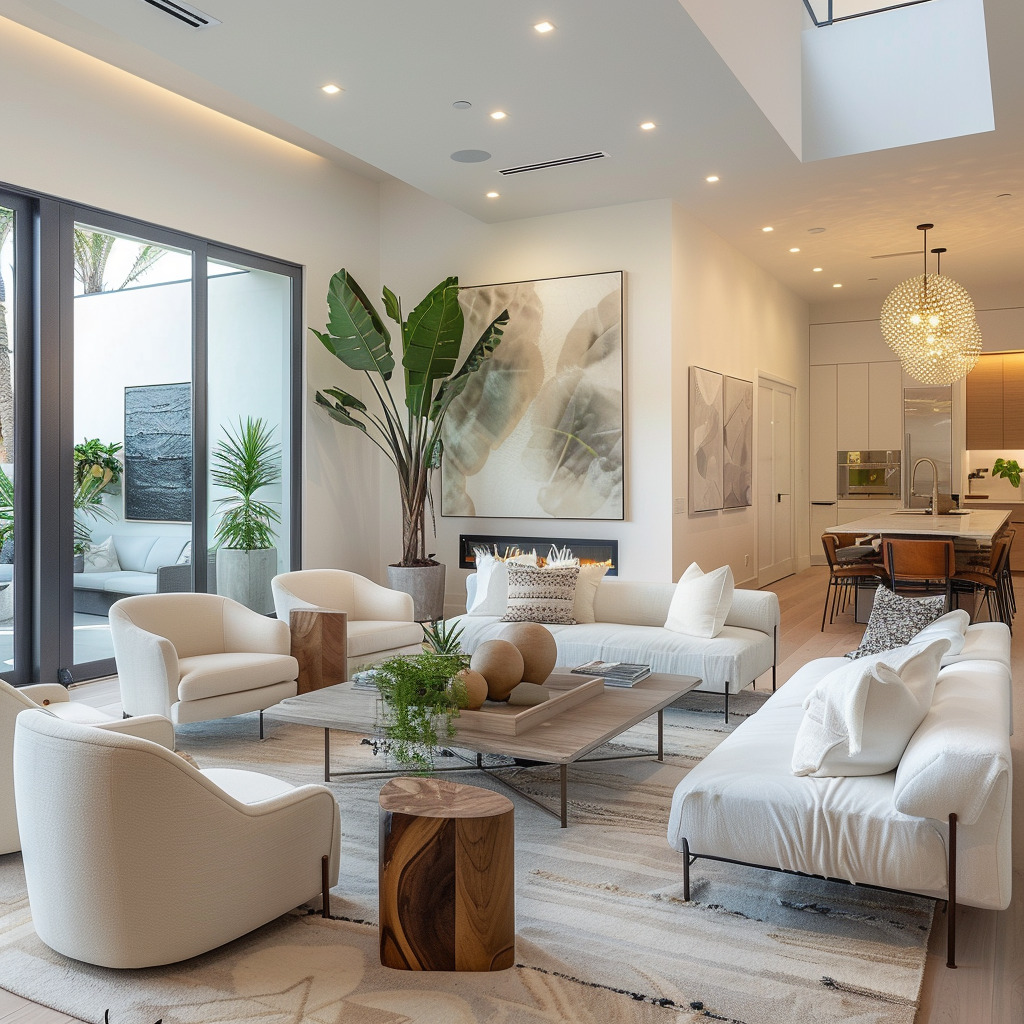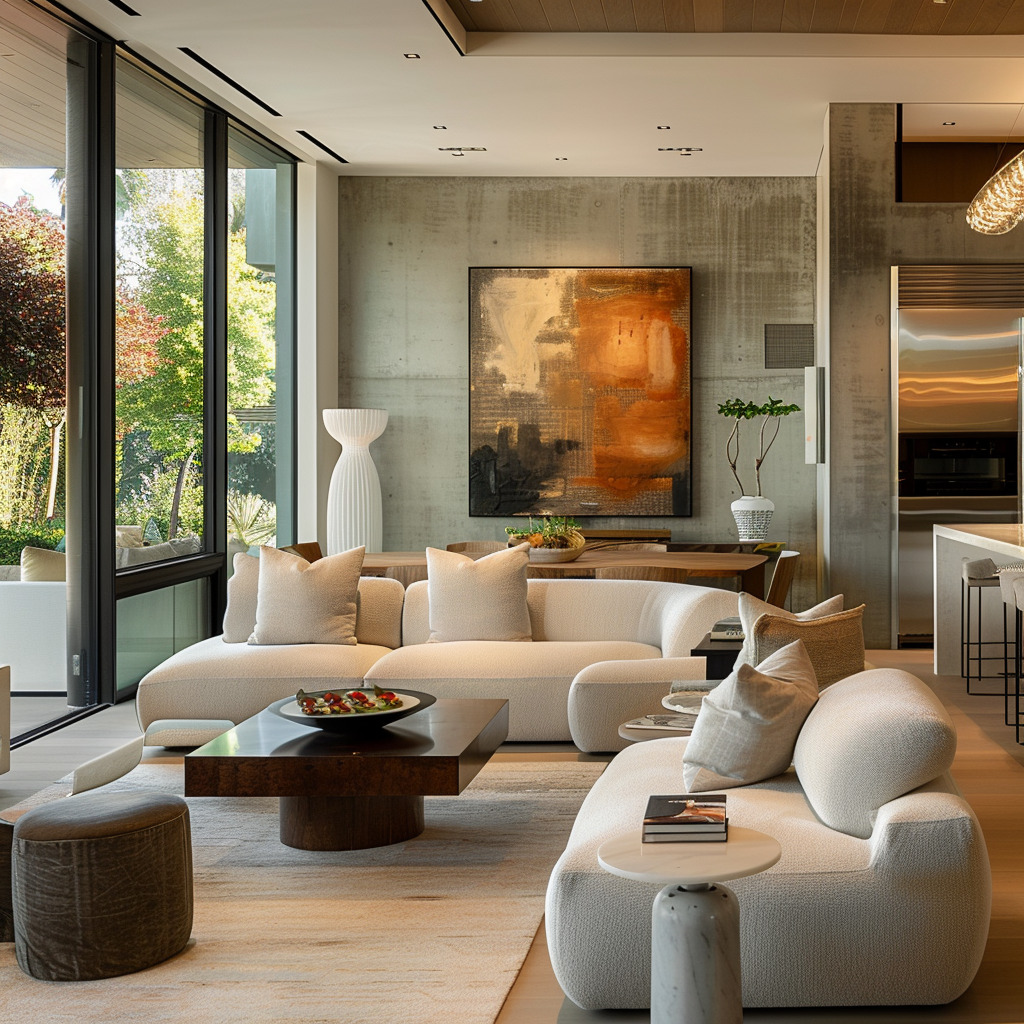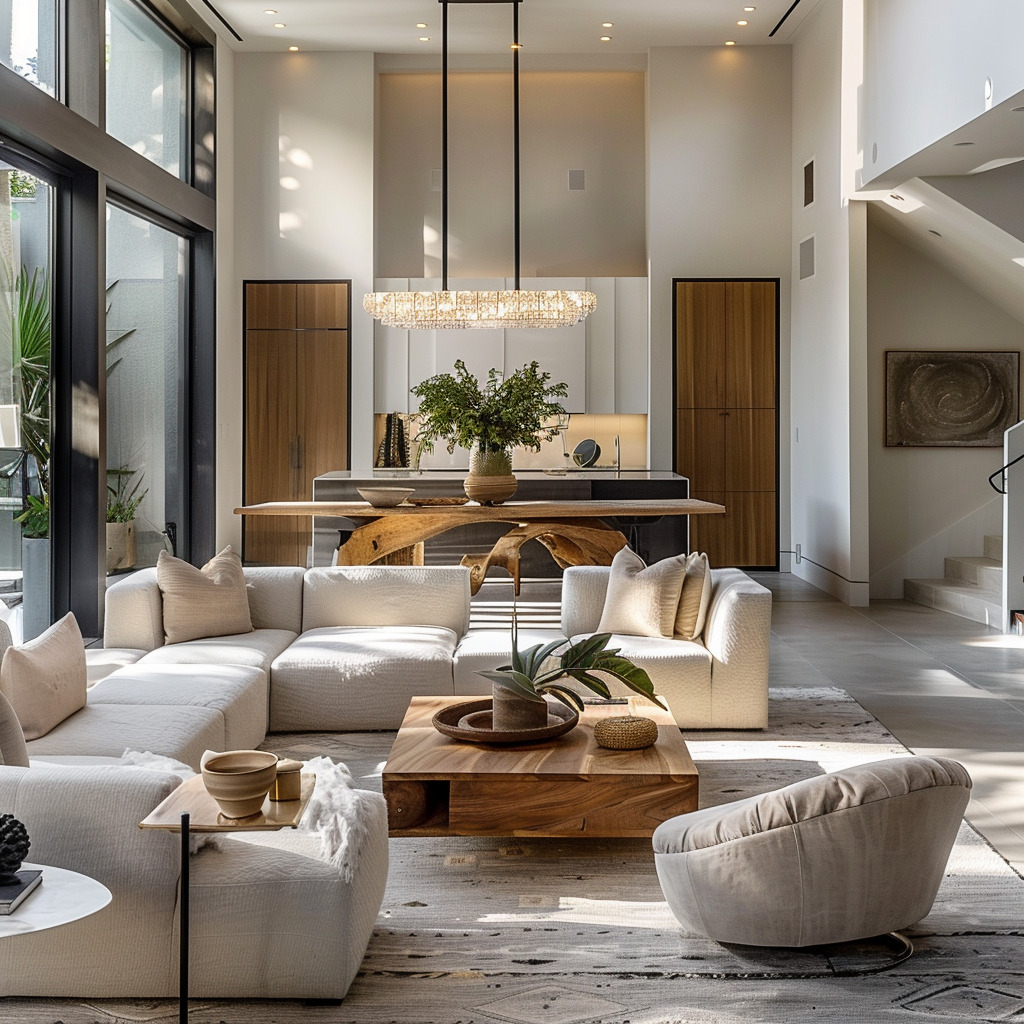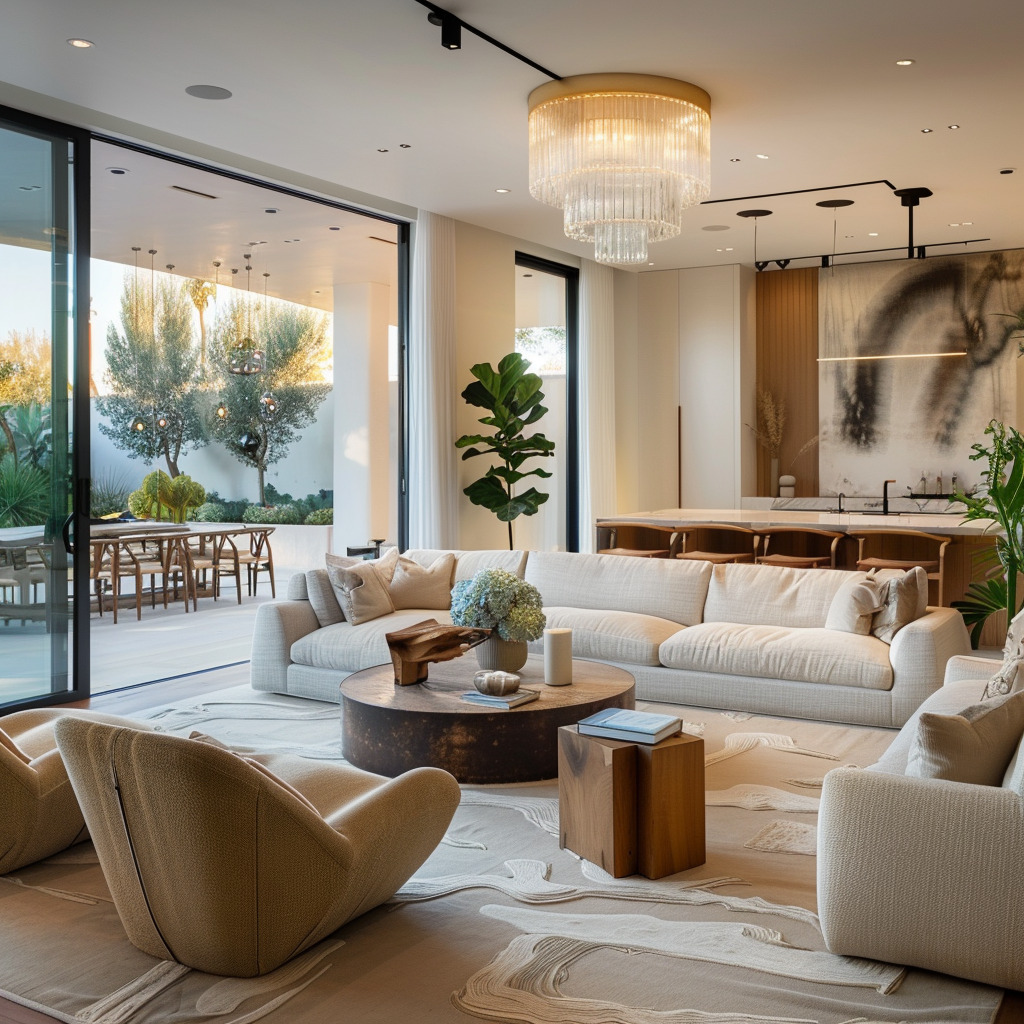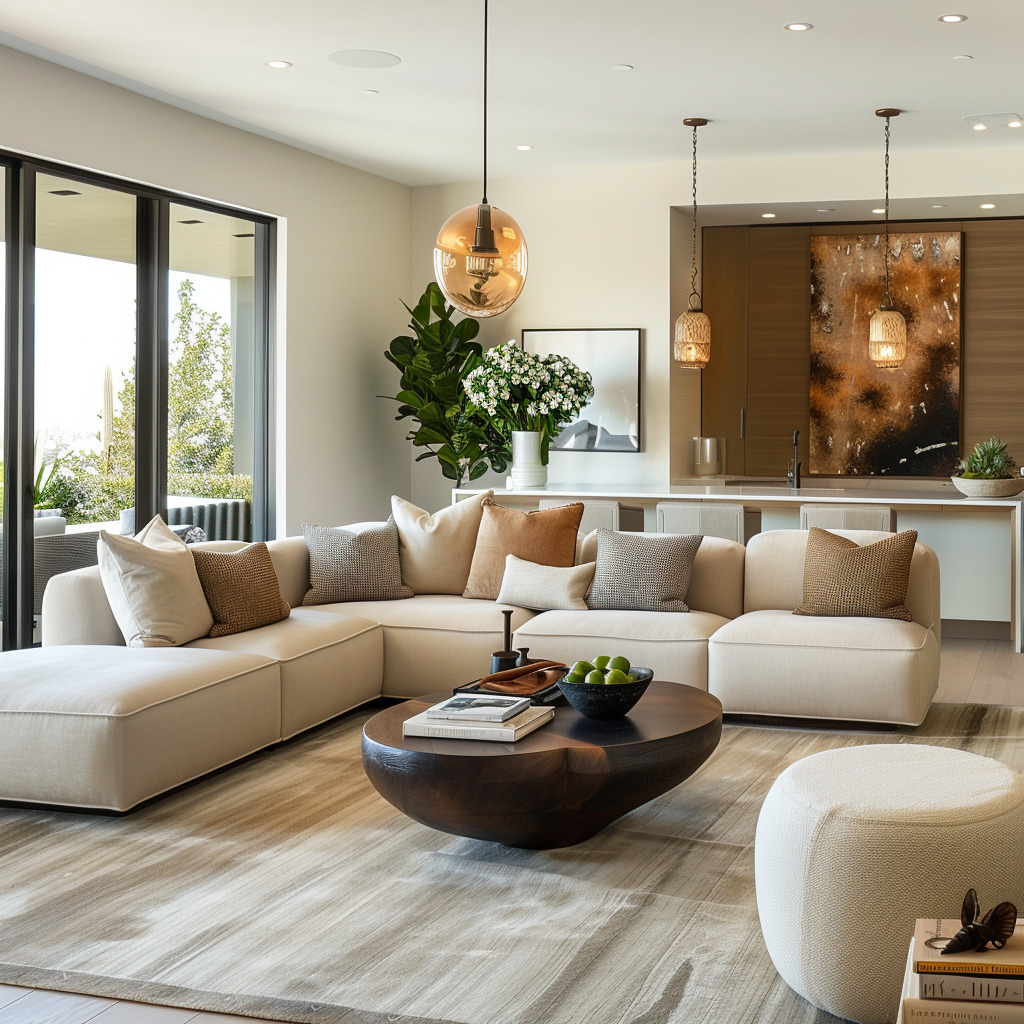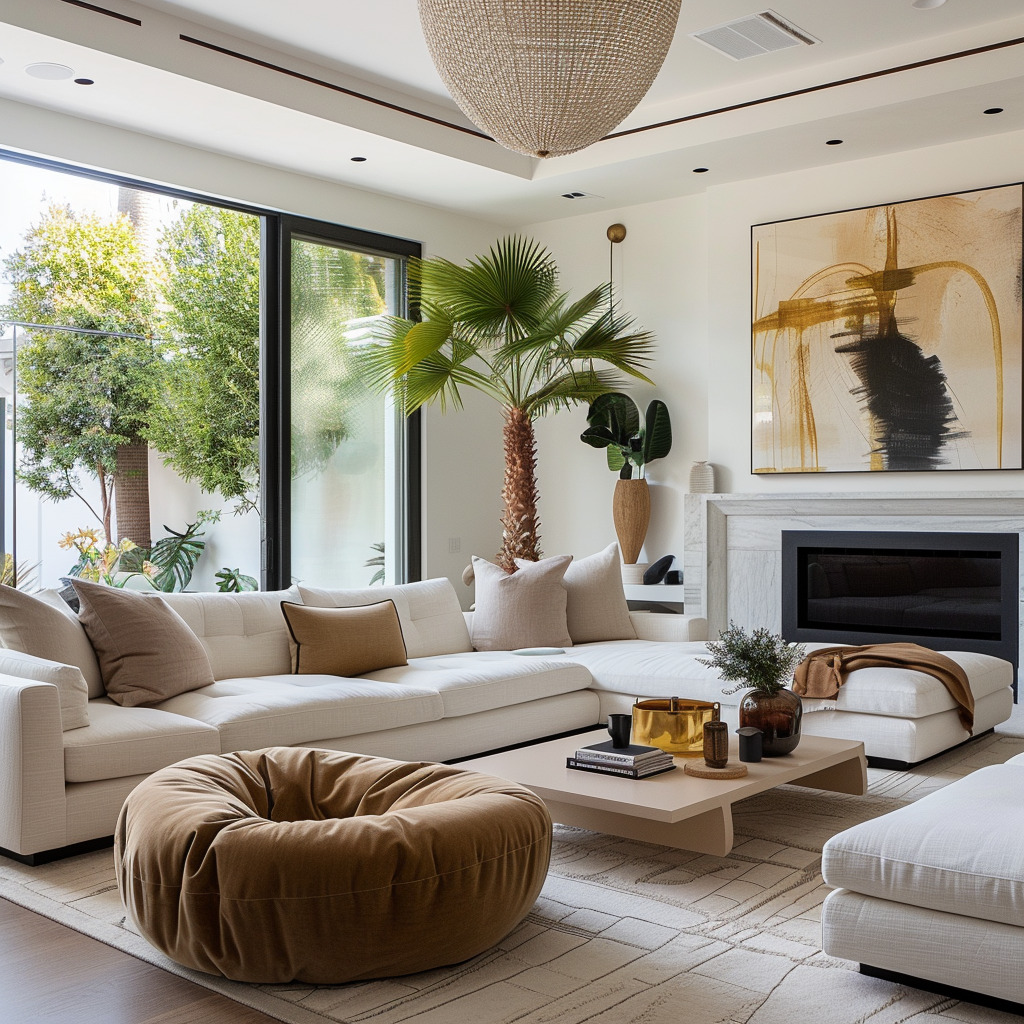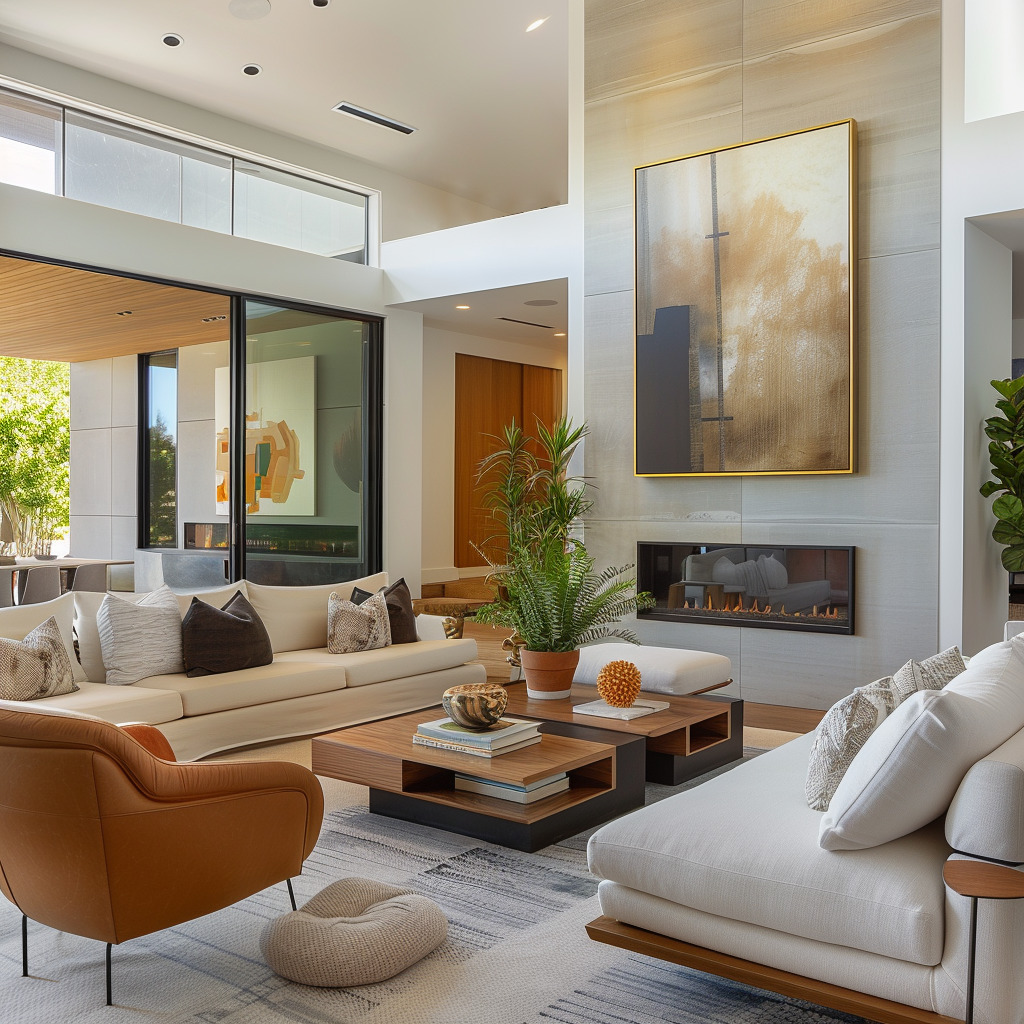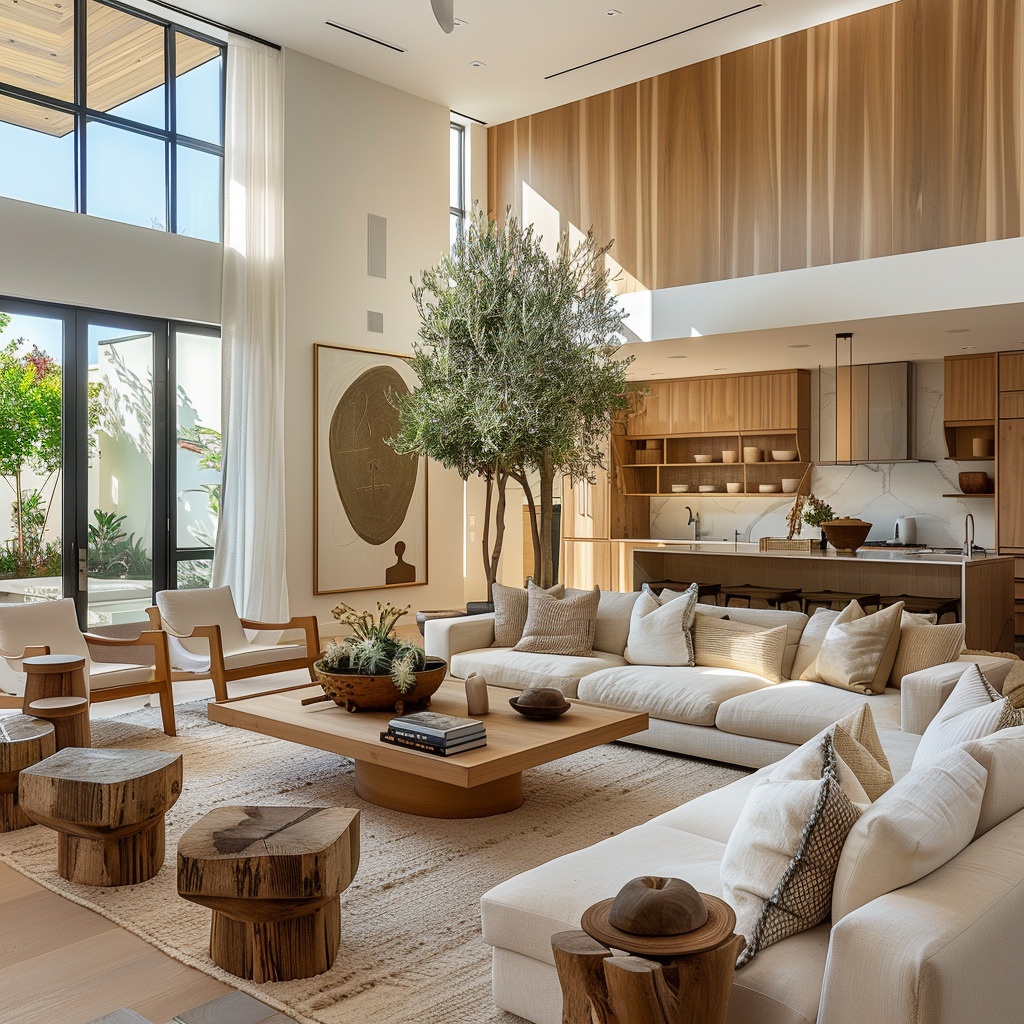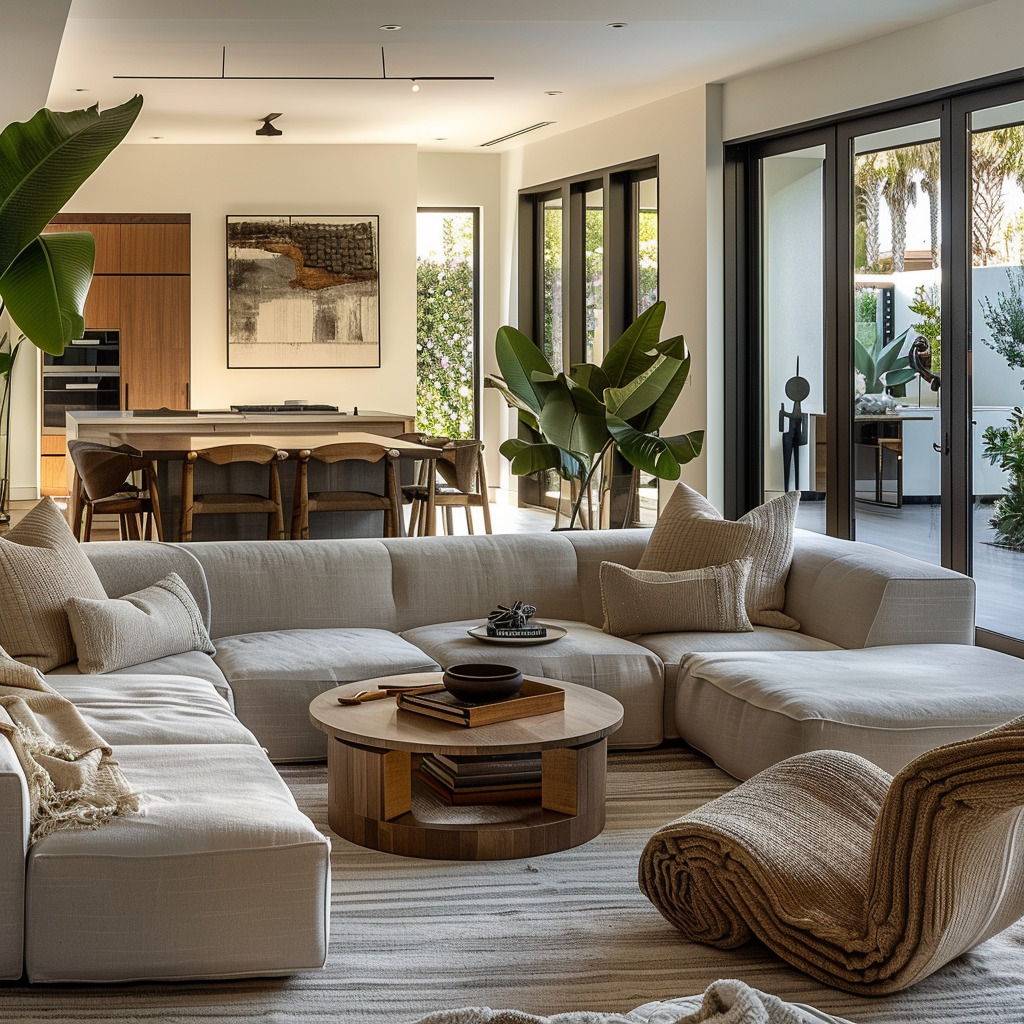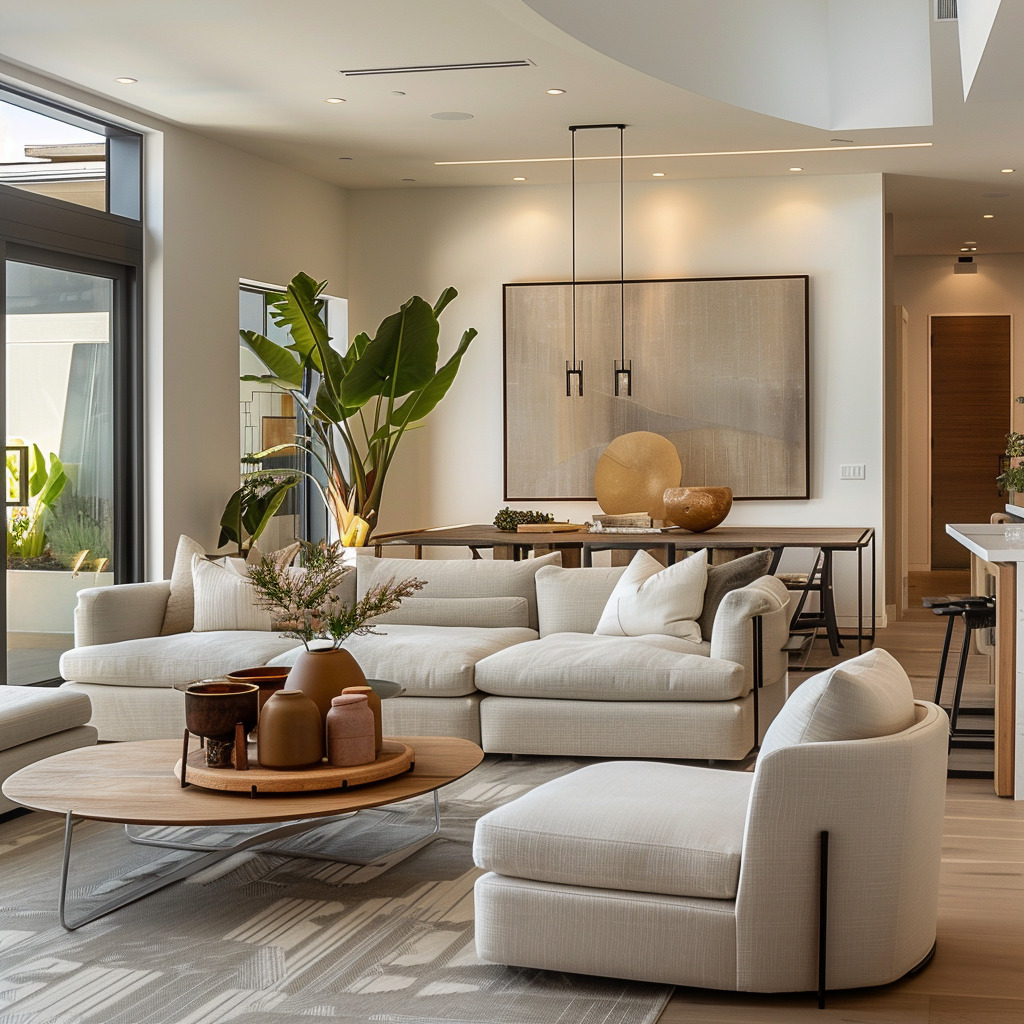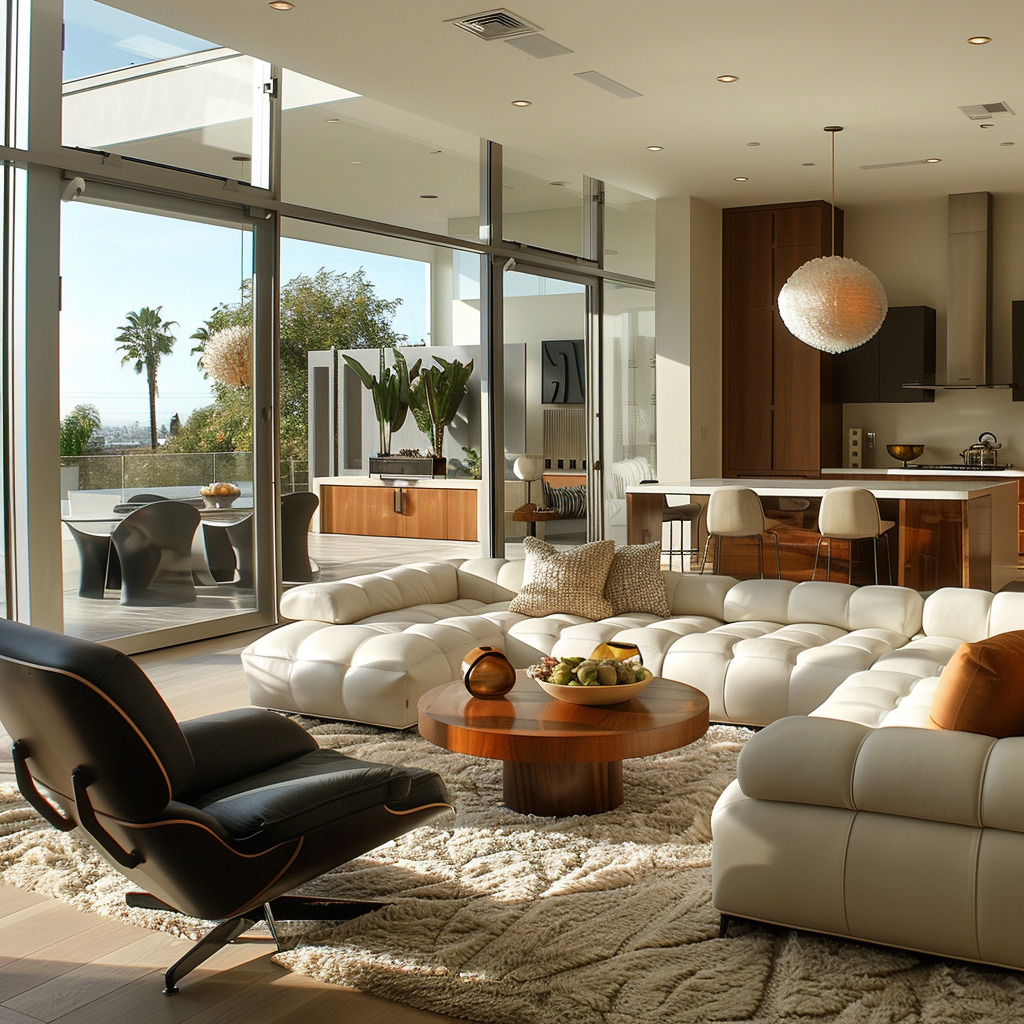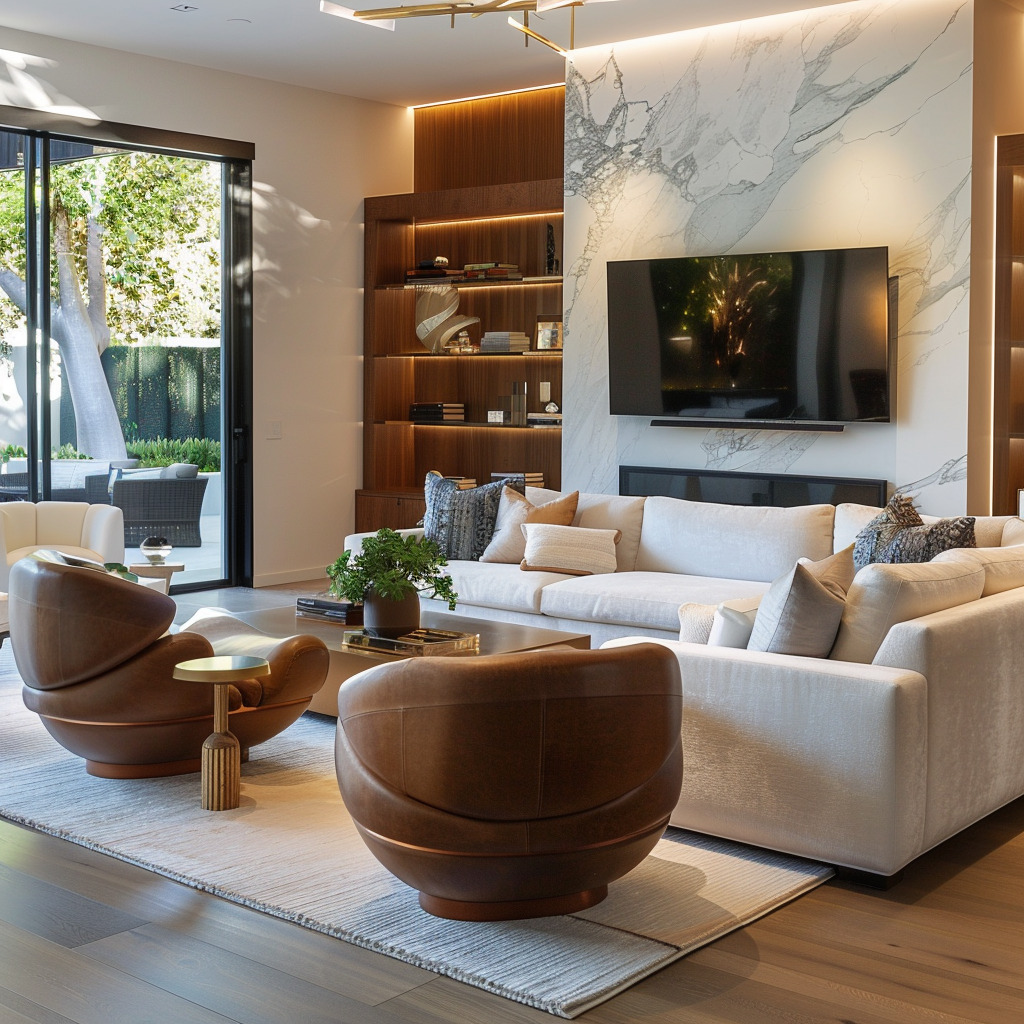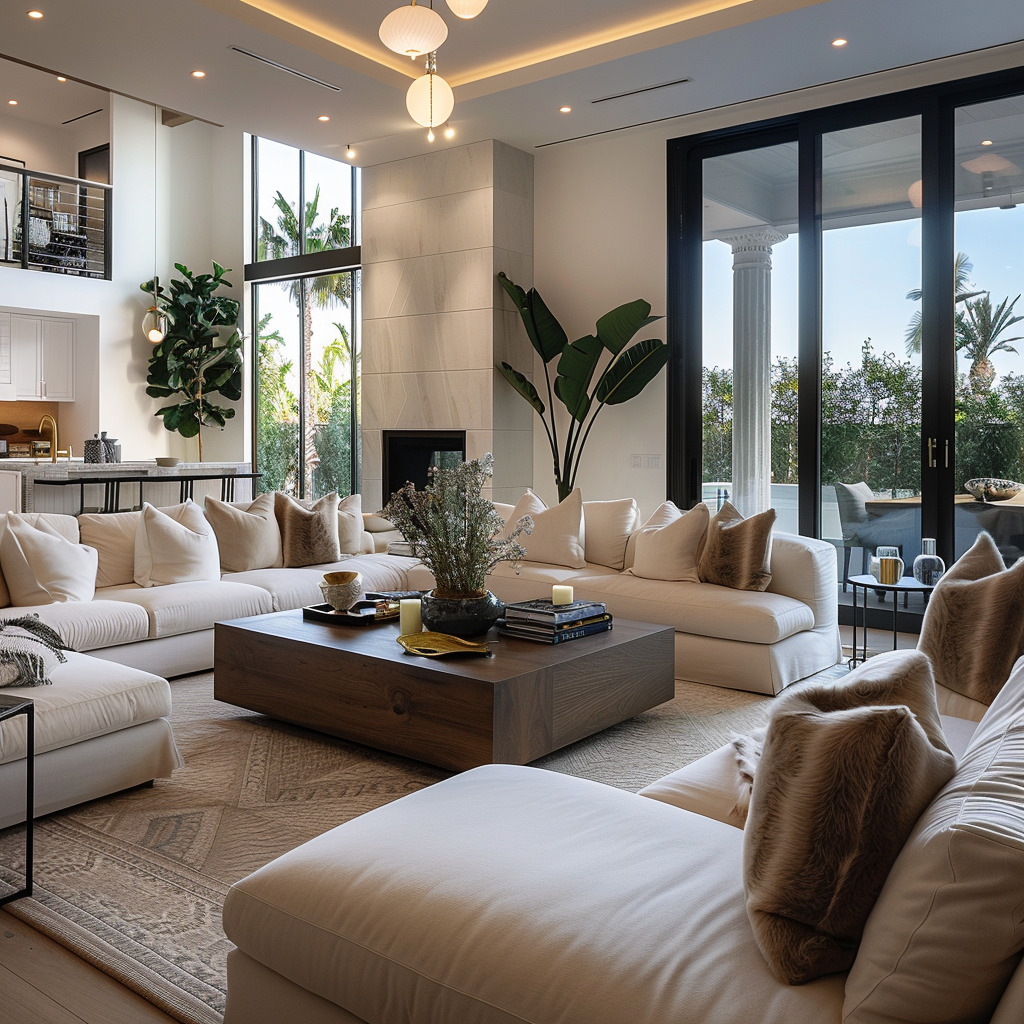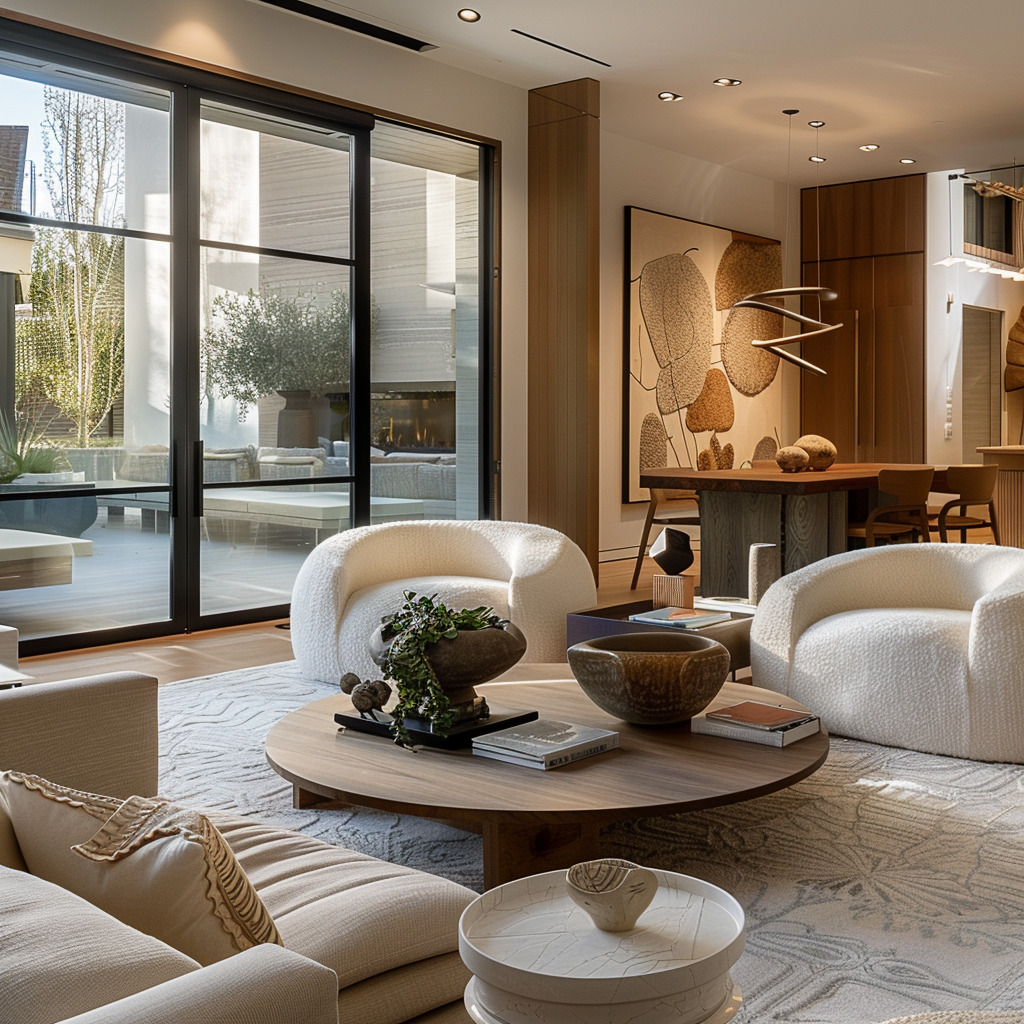The creation of a space that harmonizes functionality with aesthetics stands as a testament to the thoughtful consideration of various design elements. This article delves into the intricate details that define the elegance and practicality of modern living spaces.
From the strategic use of color and light to the careful selection of furnishings and the ingenious layout of spaces, each aspect is meticulously crafted to contribute to an overarching sense of harmony and refined living. Join us as we explore the nuanced components that come together to create living environments that are not only visually captivating but also inherently comfortable and inviting.
Color, Light, and Material Palette
Here we explore the foundational elements that define the ambiance and character of these living spaces. Delving into the artful application of a neutral color palette, the transformative power of natural light, the luxurious appeal of high-end materials, and the warmth of wood tones, this segment illustrates how these components are intricately woven together.
Each aspect, from the subtle gradations of color to the strategic use of light and choice materials, is carefully selected to create an environment that is not only visually stunning but also imbued with a sense of harmony and refined elegance.
Neutral Color Palette
The interiors reveal a sophisticated use of a neutral color palette, dominated by whites, beiges, and grays that serve as a backdrop for a clean and tranquil environment. These hues are skillfully layered with variations in shade and tone to create depth and visual interest, avoiding any monotony that might arise from a limited color range.
This palette is also instrumental in reflecting natural light, contributing to the overall luminosity of the spaces. Accents and textures in these neutral tones—like the tactile quality of a throw pillow or the smooth surface of a ceramic vase—add subtle contrasts and complexity, providing an understated elegance that feels both contemporary and timeless.
Natural Light
The presence of abundant natural light is one of the most striking features of these living rooms. Expansive windows, often extending from the floor to the ceiling, not only flood the interior with daylight but also blur the boundary between indoor and outdoor spaces.
These windows can act as architectural statements themselves, with minimal frames to allow uninterrupted views of the outdoors.
The quality of light varies throughout the day, changing the ambiance of the room from bright and invigorating in the morning to soft and golden at dusk. The strategic use of sheer draperies or none at all maximizes this light, while the reflection on various surfaces—like glossy floors or metallic fixtures—enhances the sensation of a space bathed in sunlight.
Luxury Materials
The use of high-end materials is evident throughout these living rooms, signifying a commitment to quality and refinement. Marble is used in statement pieces such as coffee tables or countertops, its veining adding natural patterns and a cool, sophisticated touch.
Leather appears in furnishings, from supple sofas to sleek chairs, offering durability and comfort while aging gracefully over time. Polished metals, used in fixtures and frame details, reflect light and add a contemporary edge.
These materials are chosen not only for their aesthetic merit but also for their longevity, ensuring that the spaces are both beautiful and built to last.
Warm Wood Tones
The inclusion of warm wood tones brings a natural, grounding element to the otherwise neutral palette of the living rooms. Wood is utilized in various aspects, from rich, walnut flooring to honeyed oak furniture, imparting a sense of warmth and organic character to the spaces.
These tones work harmoniously with the overall design by providing contrast against lighter colors and adding textural variety. The natural grain patterns in the wood also offer a unique visual detail that can’t be replicated, ensuring that even within a modern aesthetic, there’s a touch of the traditional—a nod to the timeless appeal of natural materials.
Furnishings and Decor
We delve into the careful selection and arrangement of furniture and art that defines the living spaces’ functionality and style. Emphasizing a minimalistic approach, comfortable seating, functional art, a harmonious blend of styles, and a variety of seating options, this segment illustrates how each piece and placement contributes to the overall aesthetics and utility of the room.
From the strategic positioning of art to the thoughtful mix of furniture styles, every detail is curated to enhance the living experience, ensuring that the spaces are not only beautifully appointed but also deeply inviting and reflective of a considered lifestyle.
Minimalistic Approach
In these living rooms, minimalism is key, with each piece of furniture chosen not only for its aesthetic value but also for its functionality, ensuring that nothing superfluous occupies the space. This intentional simplicity allows the architecture itself—the clean lines, the open floor plan, and the interplay of light and shadow—to take center stage.
The minimalistic approach also lends itself to an uncluttered environment, where space and form are appreciated over ornamentation. This is seen in the careful selection of low-profile, streamlined furniture that supports a clean, unobstructed view across the room, fostering a serene and harmonious environment.
Comfortable Seating
The living rooms are anchored by generous seating that combines luxurious comfort with stylish design. Sofas and chairs with plush cushions and soft, tactile upholstery invite one to sit and linger, often grouped to encourage conversation and interaction.
The seating is frequently arranged to take advantage of the room’s best attributes, whether facing a modern, linear fireplace that provides both warmth and visual appeal or positioned to offer panoramic views through expansive windows. In these layouts, comfort does not sacrifice style, with the form and function of the seating arrangements perfectly balanced to cater to both relaxation and aesthetic appeal.
Functional Art
In these interiors, art is not merely decorative; it serves as an integral component of the space’s functionality, harmonizing with the surroundings while standing out as a focal point. Sculptures in these living rooms are strategically placed, often in niches or at the termination of sightlines, where they can be appreciated from multiple angles.
Abstract art pieces command attention, their bold strokes or subdued hues contributing to the room’s overall narrative. This union of aesthetics and utility is seen in large-scale installations that anchor the space, providing not just visual impact but also a topic for conversation, thus becoming interactive elements within the living environment.
Harmonious Blending of Styles
The furniture and decor in these living rooms are not confined to a single design school but rather represent a confluence of styles that blend together seamlessly. Mid-century chairs may sit alongside modern sofas, while contemporary art pieces share wall space with more traditional fixtures.
This eclectic mix is united by a common thread of quality and compatibility; each piece is selected for its ability to complement the others, regardless of its provenance.
The harmony is achieved through a consistent color palette, similar textures, or shared lines and forms, which allows items from different eras to coexist in a way that feels both fresh and timeless. This blend of styles showcases a deep appreciation for design history and a skillful eye for composition, ensuring that the space is both dynamic and cohesive.
Variety of Seating Options
The variety of seating options in these living rooms is carefully curated to cater to different preferences and activities, ensuring that the space is versatile and accommodating. Sofas with deep, plush cushions invite lounging and relaxation, while armchairs provide a more structured sit, suitable for conversation or reading.
Poufs and ottomans offer casual, flexible seating that can be easily moved around, perfect for gatherings or when additional seating is required. Each seating type is chosen not only for its comfort but also for its design, with an eye for how it contributes to the room’s overall aesthetic.
For example, a statement armchair might introduce a new silhouette or texture, adding visual interest without sacrificing functionality.
Spatial Design and Layout
Focusing on open floor plans, high ceilings, strategic use of space, and the indoor-outdoor connection, this segment highlights how each element is integral to creating an environment that fosters interaction, embraces openness, and blurs the boundaries between the indoors and outdoors. The thoughtful arrangement and design choices contribute to an atmosphere of spaciousness and fluidity, enhancing the living experience and emphasizing a connection with the surrounding environment.
Open Floor Plan
The living rooms are characterized by expansive open spaces that effortlessly transition into adjacent areas, such as dining rooms, kitchens, or even outdoor patios, emphasizing a design that encourages social interaction and communal living. This open concept allows for activities to blend with one another, as there are no restrictive walls to compartmentalize the space.
Furniture is strategically placed to define different zones within the larger area, yet the overall feel remains unified and expansive, enhancing the home’s sense of freedom and fluidity. Such layouts often feature a continuity in flooring materials or color schemes that help to bind the spaces together visually while still allowing each area to have its functional identity.
High Ceilings
The living spaces showcase soaring ceilings that amplify the sense of grandeur and create an airy, voluminous feel. These high ceilings are not just an architectural choice but also a canvas for vertical design elements that invite the eye to travel upward, thus making the rooms appear even more expansive.
Strategically placed artwork and decor that capitalize on the verticality—like tall sculptures or elongated light fixtures—work in concert with the lofty space. Additionally, this height allows for upper windows or clerestory windows, which further open the space to the sky and natural light, enhancing the luxurious and open atmosphere that characterizes these living rooms.
Strategic Use of Space
The arrangement of furniture in these expansive living rooms is a deliberate exercise in maintaining open space, which in turn amplifies the room’s grandeur. Pieces are often grouped to create intimate settings within the larger area, yet there is a conscious effort to preserve an uncluttered feel with plenty of room to move freely.
Walkways are clear, and furniture is scaled appropriately to ensure that the space feels generous and inviting. Even in areas where the furniture is substantial, the layout maintains an open flow, guiding movement through the room with ease and reinforcing the home’s luxurious sense of space.
Indoor-Outdoor Connection
The design of these living spaces is heavily influenced by the desire to merge indoor comfort with the beauty of the outdoors. Large sliding doors not only provide access to external patios and gardens but also allow for uninterrupted views that extend the living space beyond its physical boundaries.
Windows are designed to frame the outside scenery, effectively turning the landscape into a living mural that changes with the seasons. This seamless transition between the interior and exterior is further enhanced by the continuity of materials, such as the use of similar flooring, and by the inclusion of indoor plants that echo the outdoor foliage, creating a cohesive and tranquil environment.
Accentuation and Styling
The art of accentuation and styling plays a pivotal role in defining the character and feel of a space. This section delves into how subtle accents, layered textiles, contrasting shapes, and sophisticated carpets and rugs are meticulously selected and arranged to enhance the living rooms’ aesthetic appeal and comfort, without compromising their overall minimalist and elegant design.
Each element, whether a soft cushion, an intriguing piece of art, or a meticulously woven rug, is chosen not only for its intrinsic beauty but also for its ability to harmonize with and elevate the space’s design narrative.
Subtle Accents
The accents in these living rooms are thoughtfully selected to enhance, not overwhelm, the space. Cushions with modest embellishments or throws with delicate textures provide comfort while adding layers of visual interest.
Decorative objects are chosen for their artistic value and are often in sync with the room’s color scheme, featuring soft pastels or earthy hues that complement the neutral base. These accents, whether it be a vase with a subtle glaze, a stack of books with artistically designed covers, or a carefully placed artifact, are strategically distributed to guide the eye and add character without creating visual noise.
Layered Textiles
The textiles chosen for the living spaces contribute significantly to the ambiance through their varied textures and compositions. Cushions on the sofas and armchairs come in an array of fabrics, from the smooth, cool touch of silk to the rich, inviting warmth of velvet, each adding a new layer of depth to the seating arrangements.
Throws are draped with a casual elegance, offering both a decorative accent and a cozy invitation to unwind.
The upholstery on the furniture pieces is meticulously selected to provide both comfort and durability, often in materials that age gracefully, contributing to the room’s evolving story. This layering of different textiles enhances not just the tactile experience of the space but also the visual one, as the interplay of materials adds richness and sophistication to the minimalist backdrop.
Contrasting Shapes
The interplay of contrasting shapes is a subtle but powerful design tool used in these living rooms. The clean, minimalist approach is enriched by introducing different geometric forms that create a dynamic yet harmonious look.
Round mirrors or circular art pieces provide a counterpoint to the angular forms of square or rectangular windows, breaking up the rigidity of straight lines and softening the space. Even within the simplicity of the decor, these contrasting shapes play a significant role in drawing the eye and adding a level of sophistication to the room.
It’s a delicate balance that, when struck, results in a design that is both cohesive and interesting.
Sophisticated Carpets and Rugs
The carpets and rugs in these spaces are far from being afterthoughts; they are integral components that tie the room’s elements together with their sophisticated patterns and textures. Rugs with subtle, intricate designs add a layer of complexity to the floor and can help delineate different zones within the larger open space.
Textured rugs contribute to the tactile experience of the room, inviting bare feet to enjoy the plush, cozy surface. The patterns and colors are chosen to enhance the neutral color scheme, adding warmth and depth without overwhelming the space.
These floor coverings bridge the gap between the furniture and the architecture, helping to ground the furniture arrangements and complete the visual story of the space.
Architectural and Design Details
This section delves into the nuanced interplay of structure, form, and materiality that defines the essence of these living spaces. From the strategic incorporation of textural contrasts and organic elements to the meticulous execution of clean lines and built-in features, each aspect is thoughtfully considered to enhance both the aesthetic and functional qualities of the rooms.
This segment also explores the deliberate balance between geometric harmony, symmetry, and asymmetry, as well as the purposeful use of intentional blank spaces, all of which converge to create environments that are as visually engaging as they are harmoniously balanced.
Textural Contrast
Within the restrained color palette of these interiors, texture plays a vital role in adding depth and interest. There’s a deliberate interplay of different textures, where smooth, sleek surfaces such as polished kitchen countertops are juxtaposed with the soft luxury of plush seating.
Rugs with intricate weaves or bold, sculptural forms provide a tactile quality underfoot, contrasting with the sleekness of hardwood or tile floors.
This layering of textures is also evident in accessories; for example, rough-hewn pottery complements smoother, more refined objects nearby. This thoughtful application of varied materials enriches the sensory experience of the space without relying on color, maintaining the overall aesthetic of understated luxury.
Organic Elements
The carefully curated inclusion of plants adds a dynamic and organic dimension to these living rooms, injecting color and vitality into the neutral color scheme. Greenery ranges from large, sculptural indoor trees to smaller, lush foliage, creating points of interest and a sense of well-being.
Natural wood elements, visible in furniture and structural details, contribute warmth and texture, their unique grains and tones breaking up the clean lines with their inherent, imperfect beauty. These organic touches are not only aesthetically pleasing but also promote a connection to nature, enhancing the rooms’ tranquility and providing a living contrast to the otherwise structured environment.
Clean Lines
In these spaces, the furniture and decor exemplify a design ethos where less is more. The clean, crisp lines of each piece contribute to a modern and uncluttered look, evoking a sense of order and calm.
Sofas with straight, sleek profiles, tables with simple geometric shapes, and unadorned cabinetry all adhere to a coherent design language that favors purity of form. This disciplined approach to design extends to the layout, with each piece positioned to maintain clear pathways and visual harmony, ensuring that the room feels organized and intentional.
Built-in Features
The built-ins in these spaces demonstrate a masterful blend of form and function, crafted to merge with the walls and become a part of the architectural fabric of the rooms. Shelving units are more than just storage; they are composed with a rhythm and balance that echo the minimalist ethos, displaying carefully selected items that complement the room’s design.
Cabinets conceal potential clutter, their fronts often flush with the wall, handleless or with discreet hardware to maintain a streamlined look. The integration of these features contributes to the cohesive aesthetic, ensuring that every element in the room is in dialogue with the design principles of simplicity and elegance.
Geometric Harmony
In these interiors, the geometric harmony is evident in the way different shapes and lines are balanced to create a visually pleasing environment. Circular tables and curvaceous furniture silhouettes offer a soft counterpoint to the straight, clean lines of the room’s architecture, like the sharp edges of a fireplace or the rectangular frames of windows.
This interplay between curves and angles is thoughtfully orchestrated to prevent monotony, allowing the eye to move smoothly around the space and appreciate the diversity of forms. Such harmony is achieved not by chance but through design that considers the weight, volume, and placement of each piece to ensure a cohesive look that feels naturally ordered.
Symmetry and Asymmetry
The strategic use of symmetry and asymmetry in these living rooms is a testament to the nuanced approach to design. Symmetrical arrangements, often found in the placement of sofas and chairs or the positioning of lamps and decor, convey a sense of order and formality.
They provide a classic balance that is pleasing to the eye and suggests a thoughtful organization. Conversely, asymmetrical designs introduce an element of surprise and modernity, with off-center art placements or furniture that is not mirrored but still feels balanced within the space.
This combination of symmetry and asymmetry adds depth to the design, allowing for a more dynamic and engaging aesthetic that stimulates interest and conversation.
Intentional Blank Spaces
In these living rooms, the strategic use of blank wall spaces is a testament to the belief that less can be more. By resisting the urge to fill every inch with decor, the design allows the architecture—be it an elegant fireplace, a striking window frame, or the subtle play of light and shadow on a wall—to take center stage.
These intentionally unadorned spaces provide visual breathing room, a place for the eye to rest, and underscore the minimalist approach to design that is at once confident and restrained. In this context, the architecture doesn’t just support the room; it becomes a part of the curated aesthetic, with every line, curve, and corner contributing to the overall impact of the space.
Lighting and Proportion
Let’s explore the strategic use of lighting and the careful consideration of scale and placement that underpin the elegance and functionality of these living spaces. Through layered lighting, each room is imbued with an ambiance that is both adaptable and harmonious, catering to various activities and moods.
The selective display of items and the thoughtful approach to proportions ensure that every piece of furniture and decor contributes positively to the space’s overall balance and aesthetics. This section delves into how these elements interact to create environments that are not only visually appealing but also inherently practical and welcoming.
Layered Lighting
The lighting in these living spaces is meticulously planned to create an inviting ambiance with layers that serve different purposes. Ambient lighting provides a soft glow that fills the room, established by recessed ceiling lights and discreet wall fixtures that evenly distribute light without creating harsh shadows.
Task lighting is carefully positioned to illuminate specific areas, like reading nooks or workspaces, ensuring functionality without detracting from the room’s warmth.
Accent lighting, often in the form of directional spotlights or sculptural table lamps, highlights art pieces and architectural details, drawing attention to the textures and shapes within the room. The combination of these layers can be controlled and adjusted to set the mood, whether it’s bright and energetic for hosting guests or dim and cozy for a relaxed evening.
Selective Display of Items
The shelving and display areas within these living rooms are not merely for storage but are considered an extension of the room’s design. They are carefully curated to exhibit only select items, each chosen for its artistic merit or sentimental value.
Books with visually appealing spines, unique sculptures, or cherished family photos are displayed with ample space around them, allowing each piece to be appreciated as an individual statement.
This restrained approach prevents the shelves from becoming cluttered, ensuring that the displayed items enhance, rather than detract from, the room’s overall aesthetic. The careful curation also means that the items can be rotated or changed, allowing the decor to evolve with the seasons or the homeowners’ tastes, keeping the space fresh and personalized.
Thoughtful Proportions
The consideration of scale and proportion in these living rooms is evident in the way furniture and decor are chosen and placed. Large, open spaces demand furnishings that are appropriately scaled, so sofas are often expansive, and tables are solid and grounding, ensuring that they don’t appear lost within the room.
Conversely, smaller decorative elements are proportioned so as not to be overwhelmed by the larger pieces, maintaining a balance that is both visually pleasing and functional.
Decor is not only selected for its design but also for its ability to fit within the broader context of the room, with larger walls accommodating more substantial art pieces and smaller spaces featuring more delicate items. This attention to proportion extends to the spacing between furniture, where enough room is allowed for movement, reinforcing the sense of spaciousness that is a hallmark of these designs.
In conclusion, the art of interior design transcends mere decoration, embodying a holistic approach that interweaves various elements to create spaces that resonate with both beauty and purpose. Through the exploration of spatial design, color palettes, lighting, furnishings, and more, we’ve uncovered the layers that contribute to the sophistication and functionality of modern living spaces.
These environments are not just places of residence but are carefully curated experiences that reflect the essence of thoughtful design. As we’ve seen, every detail, from the grandest architectural feature to the smallest decorative accent, plays a pivotal role in crafting living spaces that are truly harmonious and enriching.


